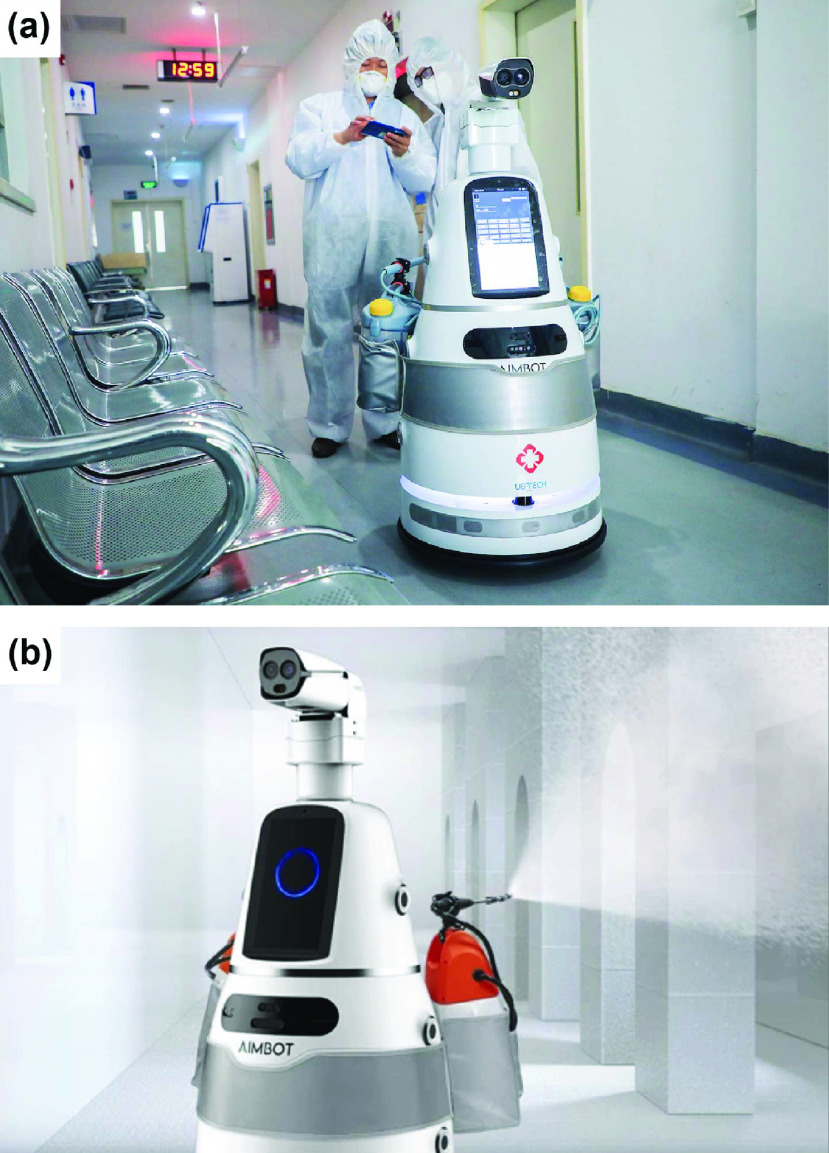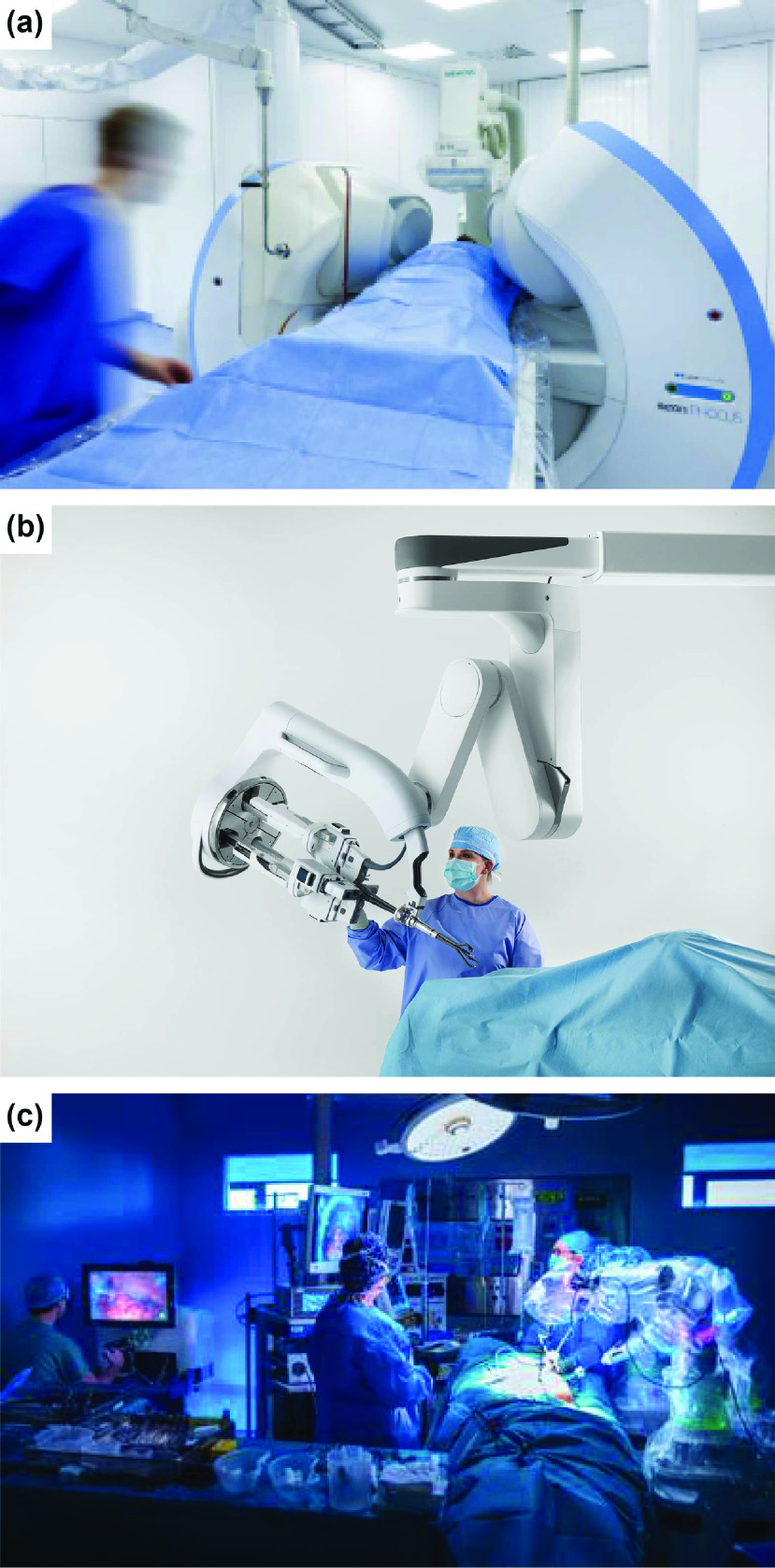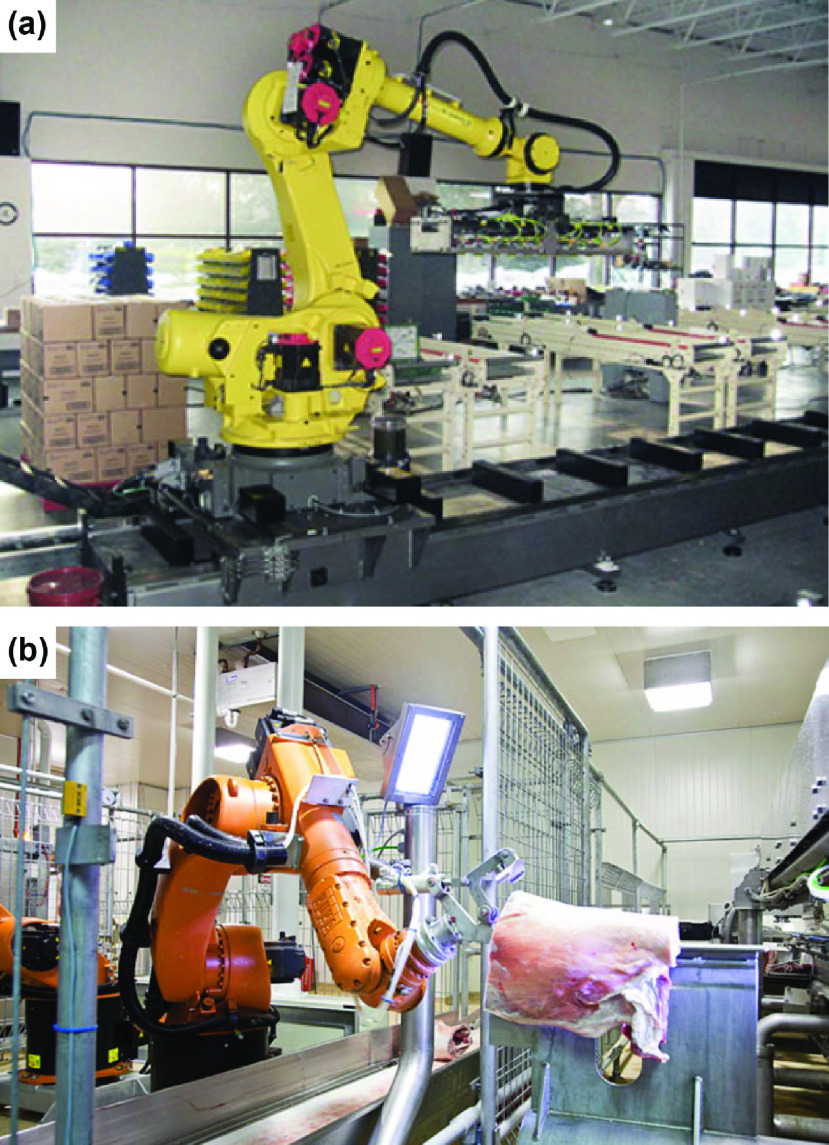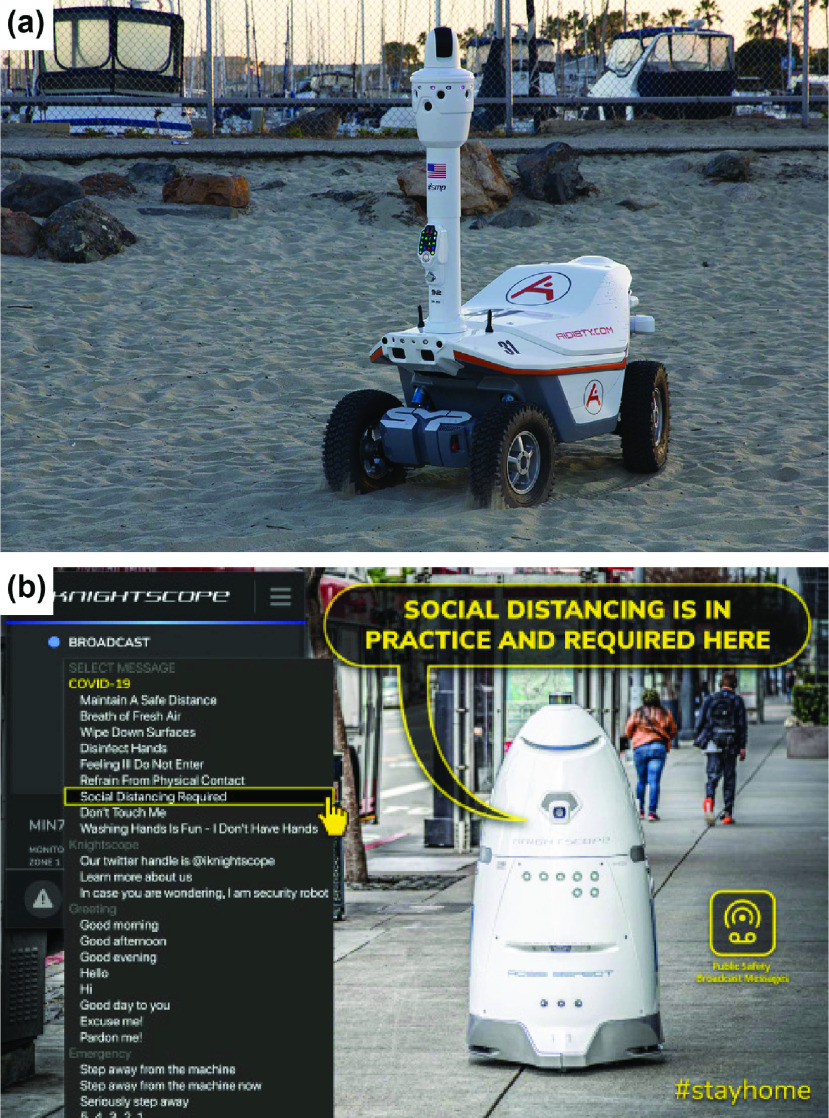Abstract
As a result of the difficulties brought by COVID-19 and its associated lockdowns, many individuals and companies have turned to robots in order to overcome the challenges of the pandemic. Compared with traditional human labor, robotic and autonomous systems have advantages such as an intrinsic immunity to the virus and an inability for human-robot-human spread of any disease-causing pathogens, though there are still many technical hurdles for the robotics industry to overcome. This survey comprehensively reviews over 200 reports covering robotic systems which have emerged or have been repurposed during the past several months, to provide insights to both academia and industry. In each chapter, we cover both the advantages and the challenges for each robot, finding that robotics systems are overall apt solutions for dealing with many of the problems brought on by COVID-19, including: diagnosis, screening, disinfection, surgery, telehealth, care, logistics, manufacturing and broader interpersonal problems unique to the lockdowns of the pandemic. By discussing the potential new robot capabilities and fields they applied to, we expect the robotics industry to take a leap forward due to this unexpected pandemic.
Keywords: COVID-19, SARS-CoV-2, robots, autonomous systems, drones, review, survey, public health, sensors, learning
I. Introduction
The novel coronavirus disease 2019 (COVID-19), caused by severe acute respiratory syndrome coronavirus 2 (SARS-CoV-2), is considered as once-in-a-century pandemic [1], [2]. At the time of this manuscript was finalized (December 14, 2020), the total infected cases worldwide have reached 72.5 million, and over 1.62 million people have died. While an effective and affordable vaccine may still not be ready [3], society is taking actions to flatten the case curve, e.g., suggesting citizens wear masks, practice social distancing, and intermittent lockdowns in different scales.
From a technical perspective, people have started deploying robots to deal with the current difficulties brought by COVID-19, such as, stopping this highly contagious virus from further spreading, improving efficiency within specific industries, and continuing necessary social functions [4], [5]. For instance, the IEEE Foundation has funded multiple robotics projects in combat to COVID-19, especially in developing countries and regions [6], [7]. In this paper, we provide a comprehensive survey of robotic systems which emerged or have been repurposed during the pandemic.
A. Motivation
1). SARS-CoV-2 as a Highly Contagious Virus
A big challenge for COVID-19 is its high contagiousness and infection fatality rate. Robots provide a very good solution to this since the virus can not replicate itself inside a robot, and the use of robots heavily reduces person-to-person contact. Elderly care facilities are especially at risk to heavy breakouts because of relatively enclosed spaces with intrinsically vulnerable population. Without a robot, healthy residents in these facilities face much higher risks of getting infected by others, e.g., an asymptomatic nurse, and then spreading it to more at-risk individuals. Many companies have migrated away from in-person interactions with customers and towards working remotely for employees (e.g., from home [8]) [9]. Although digital information can be transmitted virtually while people are isolated from each other, some necessary physical activities and resources are cannot be migrated online. Thus, robots could be of help in tasks like delivery and automated manufacturing (detailed in Part VI).
2). Increase Efficiency in Many Industries
While the direct threat from COVID-19 is infection with the SARS-CoV-2 virus, the negative social impacts are more than just this. Many industries like restaurants and tourism have had to close or to increase overhead due to the reduction in human activity caused by COVID-19 and lockdowns. The global economy optimistically waits for the vaccine, but even rapid and affordable COVID-19 tests are yet to be implemented [10]. With the reduction of active human resources in producing food, delivering necessary goods, and providing medical care, robots are an ideal means increase efficiency in many industries, including personal protective equipment (PPE) manufacturing, infection diagnosis and screening, vaccine development, and social distancing [11] and [12].
3). Continuity of Social Functions
Almost every corner of society has been affected by the pandemic and its associated lockdowns. To continue social functions, responses need to be made quickly and strategically. Taking public transportation as an example, shared vehicles such as buses, trains, airplanes, need to be fully sanitized frequently [13]. The lockdowns in many cities have drastically altered the shared economy concept (e.g., Uber and Lyft) and tourism. On the other hand, players in the food supply chain including agriculture, food producers, restaurants are suffering from the risk that workers get infected. Healthcare systems face more pressure, coming not only from the spiking numbers of new infected cases, but also from the existing needs for elderly care and chronic illness care [14]. Patients with heart disease, cancer, or diabetes suffer since their activities of daily living (ADL) which already face challenges from their chronic conditions face more challenges [15], [16]. Furthermore, existing global insurance institutions and policies are inadequate, and these require significant changes and improvements [17]. Environmental protection is also under the pressure of battling with COVID-19 (e.g., robots used for collecting trash).
B. Definition & Coverage
This paper provides an in-depth survey on the current progress of robotic systems development in tackling with challenges brought by COVID-19 pandemic. While there has been some coverage on robots during COVID-19 like [18]–[22] and [23]–[25], they are preliminary and not comprehensive enough.
We consider autonomous systems with real, physical entities as robotic systems. Usually they contain both sensors (e.g., IR sensors on mobile platforms) and actuators (e.g., electric motors on serial robotic manipulator). On the contrary, there are reviews on, e.g., computer vision techniques utilized in COVID-19 [26], which are not our focus here.
With the considerations above, the authors included drones in this review, but excluded smart wearables, internet of things (IoT), standalone computer vision techniques without real, physical entity. Over 200 reports have been covered.
C. Organization
Shown in Fig. 1 we made, the rest of the survey paper is organized as follows. In Part II, we discuss robotic systems used for COVID-19 diagnosis and screening; in Part III, we talk about robots used for UV-based and liquid-based disinfection; in Part IV, we cover surgical robots and those for telehealth during the pandemic; in Part V, we introduce social and care robotic systems and discuss the important roles they play during lockdowns; Part VI lists many robotic systems in logistics and manufacturing; in Part VII, we cover robotic systems that are not easily categorized in the aforementioned sections. Part VIII provides a summary and synthesizes our findings.
FIGURE 1.
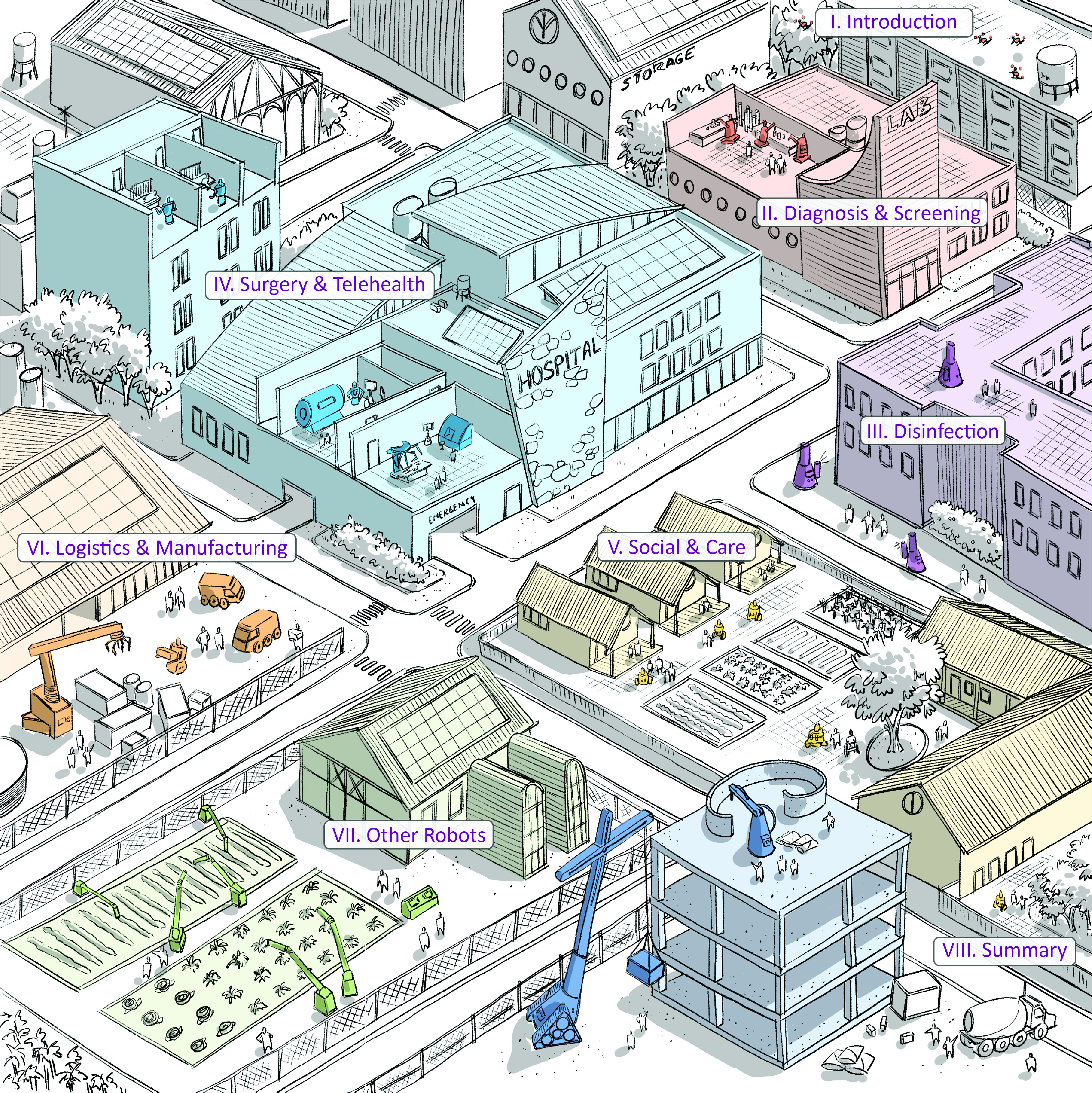
Organization of the survey. Part I: Introduction; Part II: Diagnosis & Screening; Part III: Disinfection; Part IV: Surgery & Telehealth; Part V: Social & Care; Part VI: Logistics & Manufacturing; Part VII: Other Robots; Part VIII: Summary.
II. Diagnosis & Screening
It is widely confirmed that diagnosis and screening are critical for containing the spread of the pandemic [27]–[29]. Therefore, increasing the testing accuracy and capacity has become an essential public health challenge. Many researchers have developed different diagnostic techniques to increase the efficiency and accuracy of COVID-19 testing [19], [30]–[33]. Compared with previous pandemics in history [34], [35], one highlight of this pandemic is that since the early stage of the outbreak [36], robots have already been extensively used [18], [22], [24], [37] in many creative and practical ways. Robots are showing tremendous potentials in fighting against this pandemic by accomplishing many routine tasks that conventionally require large amount of human labor, such as diagnosis [38], screening [39], mask-wearing checking [20], [26], increasing the test capacities [40], asking screening questions [41], etc. Moreover, robots of all forms are employed during this pandemic, such as stationary manipulators [42]–[44], drones [45]–[47], wheeled robots [48], mobile manipulators [49], desktop robot [50], social robots [51], etc.
A. Diagnosis
1). COVID-19 Diagnosis & Pre-Diagnosis
Swabbing is a commonly used method to collect the patients’ samples to test for the SARS-CoV-2 virus. However, manually operated swab processing inevitably exposes nurses to potential infections and manual collection is not able to meet large testing needs. Moreover, the quality of the manual collections can be inconsistent from one collector to another. Therefore, many researchers have developed different robots [52]–[54] to automate or accelerate swab sample collection (Fig. 2(a)). Oropharyngeal (OP) swabbing is widely used for viral nucleic acid detection. In [52], a robotic sampling system, which can be remotely controlled, was developed. The robot has force control mode during the sampling, and can reduce the sampling time by 50% while achieving a sampling success rate 95%, which is comparable to the manual sampling. Nasopharyngeal (NP) swab is also an effective way for a COVID-19 diagnosis. In [53], researchers developed a low-cost miniature robot that can be remotely controlled to take nasopharyngeal samples. The core part of this robot is a two-degree-of-freedom (DOF) end-of-arm-tooling (EOAT) with translational and rotational motions. The average force ranges from 0.35N to 0.85N. In [41], a real-time robot-based system was developed that can measure several vital physical signs of COVID-19 symptoms, e.g., temperature detection via infrared (IR) imaging and cough detection via acoustic data collected during verbal screening questions which are sent to a cough classification module (symptoms are classified sequentially).
FIGURE 2.
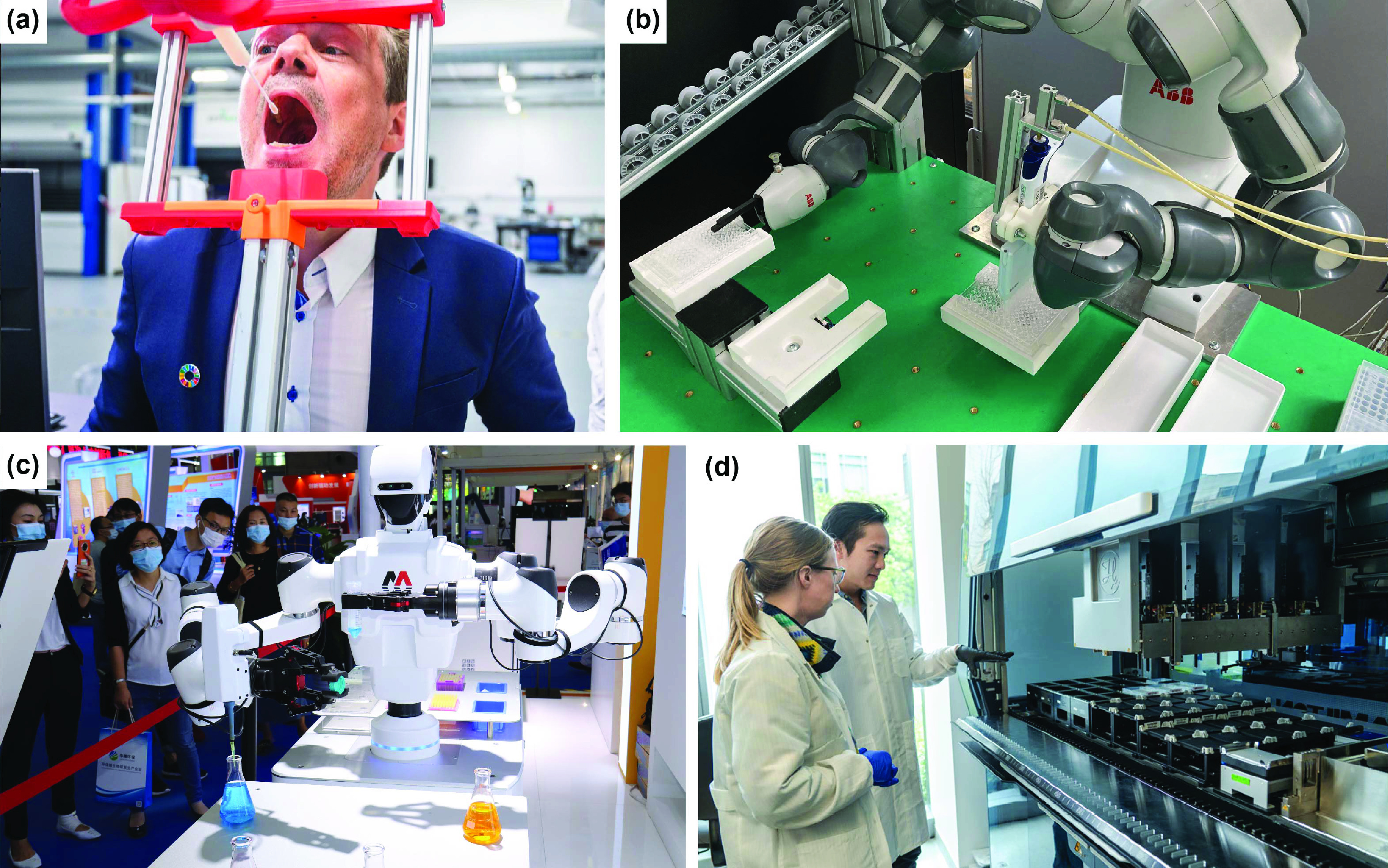
Robots for COVID-19 diagnosis. (a) Lifeline Robotics’ throat swabbing robot collecting a sample (photo credit: The Maersk Mc-Kinney Moller Institute at the University of Southern Denmark) [44]. (b) ABB’s collaborative robot, YuMi [55], was used in an application designed at the Politecnico di Milano, in partnership with IEO to support hospitals in serological testing (photo credit: Cristina Perini) [42]. (c) MOD Robot by Moying Robotics, Shenzhen, China (photo credit: Dr. Yiming Yang). (d) An automated liquid-handling robot (Hamilton STARlet) that will be used to analyze swabs from patients to diagnose COVID-19 (photo credit: Max & Jules Photography) [56].
2). Testing Capacity & Bio Lab Automation
Due to the high contagious and rapid spread [57] of COVID-19, large amount of testings are constantly needed for tracing and containing the virus. Therefore, increasing the testing capacity is important for public health systems. In Singapore, a so-called Rapid Automated Volume Enhancer (RAVE) was developed [43] using ABB’s high-precision robots [58], which greatly saved time and costs and kept lab workers safe. This system can increase the throughput to 4000 samples a day, by automating some sample processing work that conventionally requires manual work. In Italy, cobot Yumi [55] was developed to support and accelerate the serological testing [42], in which the “pipetting” process is automated to reduce the human tester’s fatigue from pressing the pipette repeatedly (Fig. 2(b)). Thus, samples can be analyzed up to 450 samples/hour. Similarly, Moying Robotics, a startup from Shenzhen, China developed a dual-arm robot (Fig. 2(c)) that could be used to handle hazardous biomaterial sampling. In [56], researchers integrated a robotic liquid handler [59] and a polymerase chain reaction (PCR) machine to automate the testing procedure and increased testing capacity to hundred of samples daily (Fig. 2(d)), with the ability to increase to 3000 samples per day. An ultra-high-throughput Mass Spectrometry (MS) platform [60] was developed for Clinical Proteomics; by conducting the sample pipetting and mixing with liquid handling robots, the workflow can handle up to 180 samples per day. In [61], researchers used liquid-handling robots, RNA extraction and quantitative reverse transcription PCR (RT-qPCR) reagents to set-up a reproducible workflow for RT-qPCR SARS-CoV-2 testing. With automated SARS-CoV-2 PCR testing, increases in capacity and improvement in testing flexibility can be better adapted to future protocol changes.
B. Screening
Screening [39], [62]–[64] is an inexpensive but effective way to help identify and control the COVID-19 symptoms, especially in populated areas. In [39], a mobile robot was equipped with high-accuracy thermometers, which were particularly developed for outdoor usage. With an intelligent temperature compensation algorithm, an accuracy to within 0.2°C was achieved in an outdoor environment. Dr. Spot (Fig. 3(a)), a quadruped robot was developed [62], [65] to contactlessly monitor vital signs such as skin temperature, respiratory rate (RR), heart rate (HR) and blood oxygen saturation (SpO2), which conventionally requires in-person contact. Robot-controlled IR and multi-monochrome cameras are utilized to track the facial skin temperature, HR, RR and SpO2. An agile robotic system can adjust the distance and angle of the view of IR to properly obtain vital signs from patients. Three monochrome cameras, outfitted at wavelength 660nm, 810nm, and 880nm, are simultaneously used to measure HR, RR, and SpO2. Another advantage of Dr. Spot is that it is not limited by stairs. Dr. Spot also has a tablet screen to perform telemedicine. Drones [47], [66], [67] have the advantage of not being restricted by the terrain, and can be equipped with different temperature sensing components, such as IR sensor, thermometer, thermal camera, etc. Thus, drones are effective in screening the temperature in public places. In [47], a drone was used to monitor people’s temperature in a high residential building (Fig. 3(b)). Draganfly [46], [68] developed drones (Fig. 3(c), Fig. 3(d)) to detect physical signs such as temperature, heart rate, respiratory rates, coughing/sneezing in crowds, etc. It uses specialized sensors, machine vision and AI algorithms to achieve above-mentioned monitoring purposes. UBTECH [48], [69] developed robots like Aimbot and Cruzr that can accomplish the temperature screening in different indoor and outdoor conditions. Misty Robotics [50] developed a social-robot-like desktop robot with temperature measure capability and human robot interaction (HRI) features such as health screening questions (Fig. 3(e)). The thermal camera can provide 0.5°C accuracy. In [70], a 5G patrol robot, which is equipped with 5 high-resolution cameras and infrared thermometers, is capable of scanning the temperature of 10 people simultaneously within a radius of 5 meters and can monitor mask wearings. Any suspect cases will be automatically sent to the relevant authorities.
FIGURE 3.
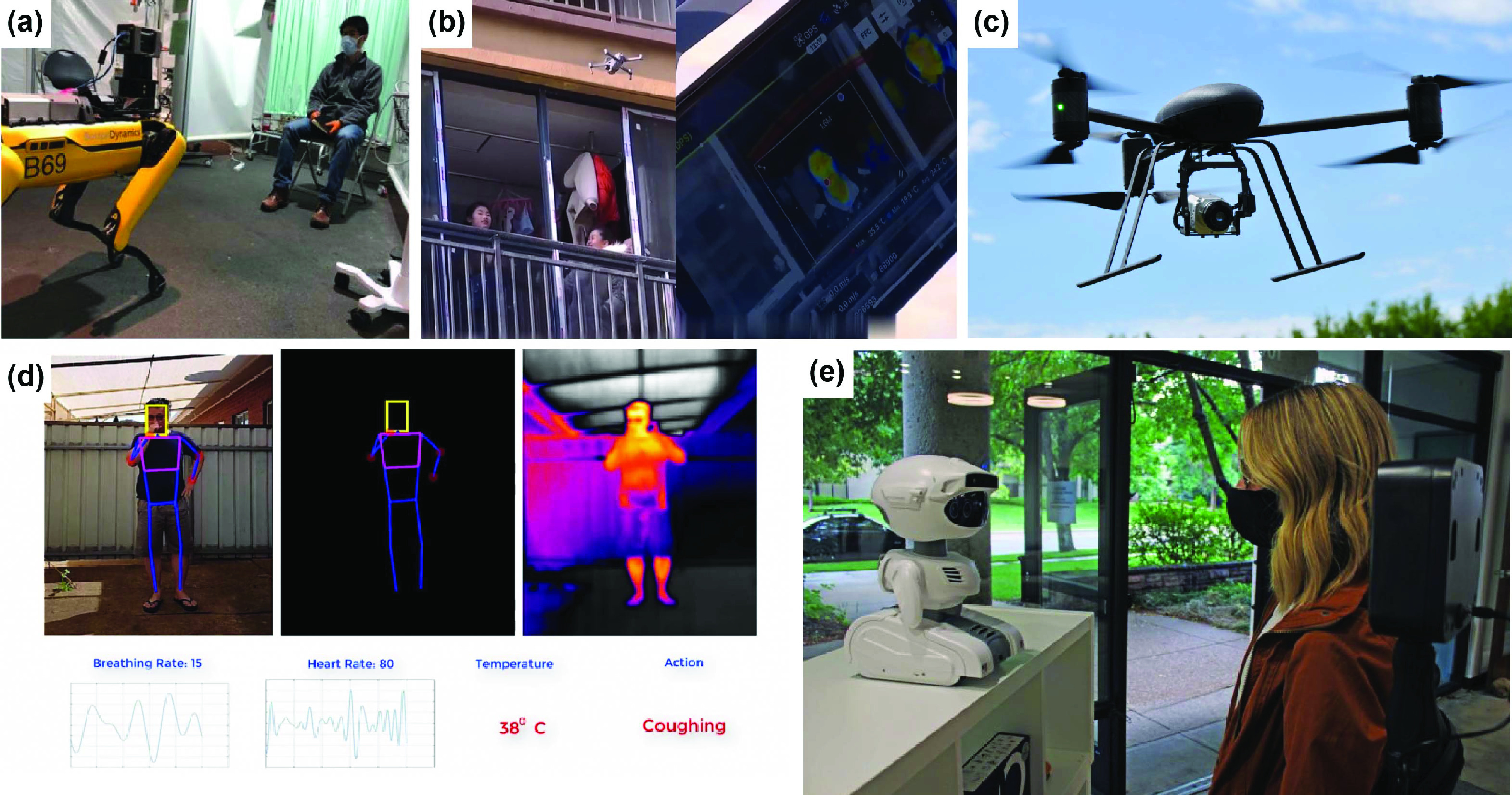
Robots for screening. (a) Quadruped mobile robotic platform Dr. Spot for contactless vital signs monitoring [62]. (b) Drones equipped with infrared cameras to measure the temperature of people who was quarantined in their apartments (photo credit: geospatialmedia.net) [47]. (c) The Draganfly drone (photo credit: Draganfly) [46]. (d) The pandemic drone can detect individuals with a combination of elevated body temperature, elevated heart rate, indicative respiratory rates and coughing (photo credit: Draganfly) [46]. (e) Misty screening a person with temperature sensing capability and asking screening questions (photo credit: Misty Robotics) [50].
C. Advantages
Compared with conventional diagnosis and screening, robots have the following advantages. First, robots can work intensively in risky environments, greatly reducing the unnecessary contact between the medical staff and patients, therefore increasing healthcare workers’ safety [71] and reduce their pressures [72]. Second, a robot can work extra long hours, therefore greatly reducing the fatigue of the doctors and nurses. For example, in the serological testing presented [55], one purpose of the automated pipetting is to release lab technician from the exhaustive work of pressing the pipette. Third, a robot can automate many testing procedures and therefore increase efficiency and throughput. Fourth, the robot can leverage multiple sensors to accomplish multiple tasks simultaneously. Many robots developed during COVID-19 are equipped with multiple sensors such as cameras, thermal sensors, IR, speakers, microphones, etc. For example, many multi-functional social robots have expanded their roles and started to have diagnosis functions such as temperature checking and questionnaires [51], [73]. Finally, the booming of robot applications are catalyzed by the new information technology development. With these new technologies, the robot can not only perform many tasks as a standalone unit, but also help to share the information and build a complete network to better tackle this pandemic. Because of the above powerful capabilities, robots are found in every corner of the front line and have become our essential warriors in this battle against the COVID-19.
D. Challenges
With all the above-mentioned promising development of the robot technologies in this COVID-19, there are still a lot of challenges to face.
First, the level of autonomy needs to be continuously improved. For example, some robot-assisted sampling procedures can avoid close contact between the medical staff and the patients, but teleoperations are still required to finish the sampling. Therefore, if the fully autonomous procedure are wanted, a lot of components have to be integrated, such as HRI, computer vision, AI, etc.
Second, the reliability needs to be guaranteed in many applications. For example, the robot needs to have superior safety features since it either directly interacts with human or works in a densely populated environment. Also, many technologies need to be refined for medical use. For instance, AI and computer vision are widely used in human detection, face recognition, diagnosis, etc. Any false positive or false negative mistakes will cause great risk for the public heath.
Third, sensor technologies and underlying components of the robot need to be improved. Robotics is a complex system engineering field and every single component can contribute to the overall performance. For example, temperature screening is important at hospitals and other public places. The temperature measurement accuracy is crucial for this purpose. Advanced thermal cameras are accurate in temperature measurement, but high-end thermal cameras are prohibitively expensive thus unrealistic to be massively deployed. Beyond the hardware development, many algorithms are developed to monitor vital physical signs from sensor data. How to extract the useful information from the sensors and get the desired accuracy/sensitivity is also a nontrivial task. Some tasks require improvement of both hardware and algorithms, for example, monitoring crowded public areas in real-time requires abundant computing power and reliable algorithms.
Finally, building a complete network also requires massive amount of work. Most robots reported so far are working as individual units, although some robots can report suspicious cases to supervision departments. In the future, more robots can be connected through modern infrastructures such as IoT, 5G, AI, cloud technology, etc. A smart network can thus be formed by intelligently leveraging all the available information to monitor the pandemic situation within the whole community or society, instead of a single hospital or building. This smart network can provide much more effective guides for fighting the pandemic and policy makings.
III. Disinfection
Autonomous robots are ideal for working in places that are dangerous to humans, such as mining [74], nuclear plant maintenance [75], and underwater exploration [76]. In the same way, robots are ideal for tasks that are risky for humans, such as disinfecting areas to prevent the spread of the SARS-CoV-2 virus [77].
Robots for disinfection can be divided in two main branches: light based and liquid agent spray [77]. These robots can be mobile based, drones or semi-autonomous mechanisms, requiring a human-in-the-loop operation [78].
A. UV-Based Disinfection
A common way to sterilize bacteria and disinfect fresh water is using ultraviolet (UV) technology. In the early 1900’s, Niels Finsen won the Nobel Prize in Physiology or Medicine for his use of UV light on the skin for disinfection. There are three types of UV lights, they are UV-A (315 to 400nm), UV-B (280 to 315nm), and UV-C (100 to 280nm). UV-A and UV-B rays are what caused the sunburns on humans. However, UV-C rays are more intense and are usually blocked by the Earth’s ozone layer. UV lamps used in disinfection are commonly UV-C type; these can emit 20 joules per square meter per second (at 1-meter distance) of 254-nanometer light, which guarantee to kill 99.99 percent of germs.
In order to disinfect a surface with UV light, the surface is only exposed directly for a couple of minutes since the UV radiation can cause damages to human if the exposition is longer, especially in eyes and skin. A common way to disinfect areas and spaces with UV is with mobile systems such as robotic carts or to use systems moved by humans such as small handheld devices for disinfecting specific areas [78]. However, robotic solutions are favored when disinfecting multiple rooms or highly contaminated places with COVID-19, such as hospital rooms [77].
The robotic UV platforms are essentially mobile robots with adapted UV lights on top of them. These robots commonly integrate sensors for navigation and detection, such as lidars, cameras, infrared and ultrasound sensors. The robots fuse the sensors to perform simultaneous localization and mapping (SLAM) to find their way when navigating through the room and to avoid obstacles and detect any humans that may walk in front of the robot. In this setup, robotic UV platforms can include a map of a facility and navigate autonomously to a schedule base, autonomously recharging and performing disinfection 24/7 without human supervision. These robots normally integrate the algorithms for human detection and automatically deactivate the UV in the presence of humans. In addition, the disinfection process is more consistent than if performed by a human, while the medical staff is freed from this repetitive task to do more meaningful tasks such as taking care of the patients [79].
During this pandemic, different types of disinfection robots have been developed to fight against the novel coronavirus crisis. Some designs are mainly mixed matches of commercially available mobile platforms with customized UV lamps, while other robots are more sophisticated with complete robotic mechanisms tailored for switching on/off UV-C lamps while covering entire floors in a building [80].
The MIT UV robot, which operates in food banks, consists of a commercial base from AVA robotics together with a customized UV light controller. The robot includes four UV-C lamps, and it takes 30 minutes to cover 370 square meters with a nominal speed of 0.1m/s [79]. Another example of mobile platforms topped with UV is the UV-C robot 2.0 by Building Momentum, which is a line-follower mobile platform topped with 6 UV-C light. Similarly, Violet from Akara Robotics Ltd., is a disinfection robot that can sense people and turn off its emitter if necessary. Violet is basically a “turtlebot” mobile platform with a single UV-C lamp attached on top. The small footprint makes it very accessible to move in narrow corners in hospital rooms with multiple medical devices [81].
Commercial UV robots are well-defined products with full sensing capabilities to understand their working environment, able to detect people, automatic recharge capabilities and perform pre-programmed routes for 24/7 service (as shown in Fig. 4).
FIGURE 4.
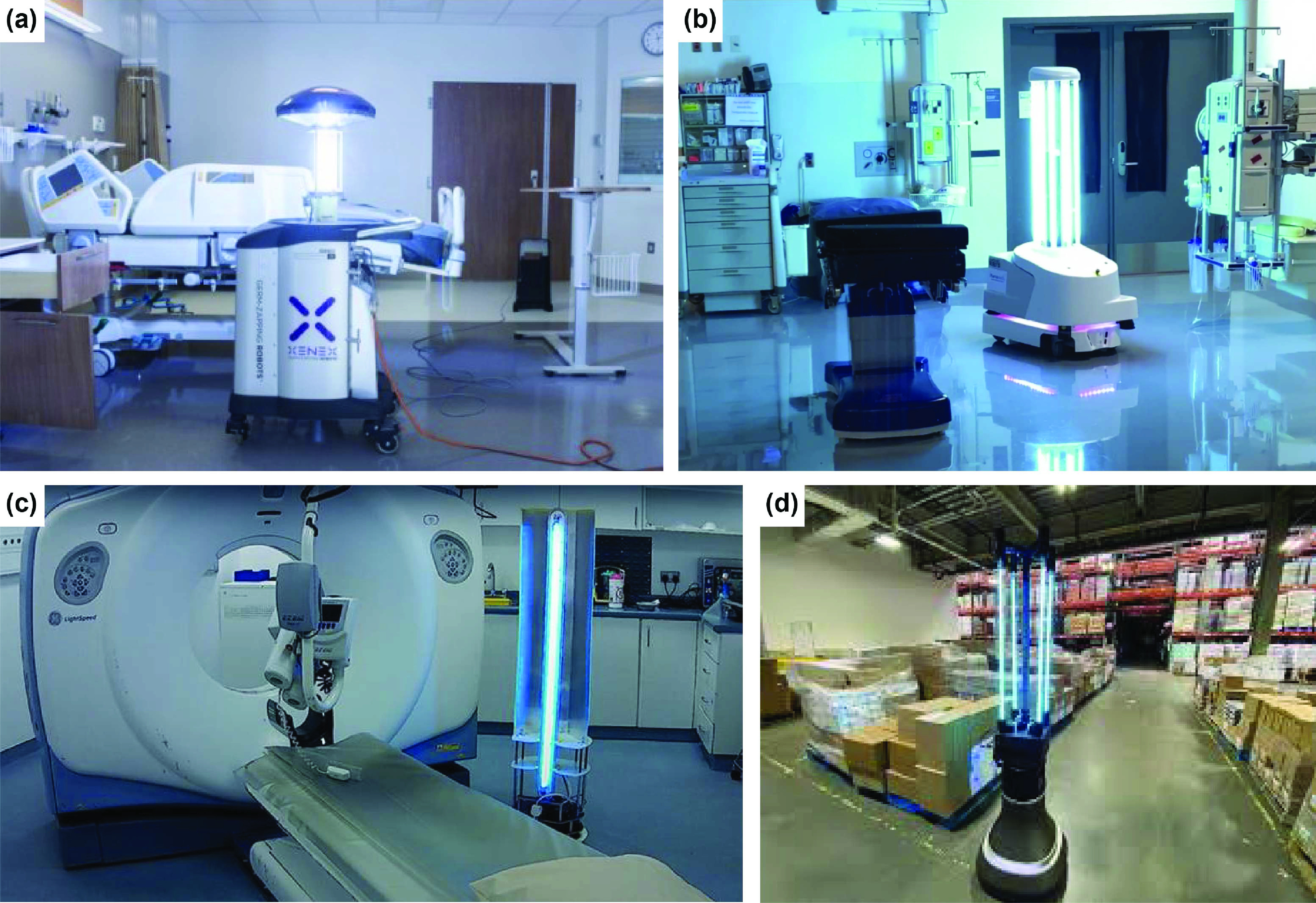
UV-C robots. (a) Xenex light strike robot (photo credit: Xenex). (b) UVD robot moving and disinfecting a surgery room (photo credit: UVD Robot). (c) Akara robot disinfecting corners in a laboratory room (photo credit: Akara Robotics). (d) MIT UV robot disinfecting food bank (photo credit: MIT).
UVD Robot is a Danish company developing robots for disinfecting hospital rooms, trains, and airplanes. The robot is designed to have small footprint and full sensing capabilities. It is equipped with 3D sensors for understanding all the details from the scene, recognize obstacles and implement a logic that prevents the activation of UV-C rays in the presence of humans or when the robot is too close to a wall or an object.
Omron developed a robot equipped with lasers and passive infrared (PIR) motion sensors for obstacle detection and avoidance. It can maneuver through narrow corridors, elevators, and automatic doors. The robot can shut off its UV-C light upon detecting people to avoid radiation exposure. The robot can follow a mapped route indoors, reducing the need for staff time dedicated to manual cleaning. The robot also includes safety features such as a bumper, sonar, and emergency stop, plus an automatic charging and a smooth touch interface for control.
Geek+ Technology Co. developed Lavender, a robot with UV light for disinfection. The autonomous mobile robot is designed to automatically avoid obstacles and to work around the clock in spaces including warehouses, offices, schools, stores, transportation stations, and hospitals. The disinfection robots can run and recharge without human intervention. They use SLAM to navigate the robot in challenging spaces surrounded by medical equipment. The use of multiple sensors enables the robot to detect objects and interact with the building’s infrastructure, so that they can operate in complex environments, even manipulating elevators.
Xenex’s developed a pulsed, high-energy light robot. The broad-spectrum UV light technology used by Xenex’s robot is uniquely lethal to microorganisms – it is
 more intense in peak power than a mercury lamp. The fast disinfection cycles can provide the capability to disinfect a patient room in as little as 10 minutes and to disinfect the surgical suite in 20 minutes or less.
more intense in peak power than a mercury lamp. The fast disinfection cycles can provide the capability to disinfect a patient room in as little as 10 minutes and to disinfect the surgical suite in 20 minutes or less.
UBTECH is developing a re-configurable autonomous UV-C robot, which can navigate in healthcare and hospital facilities. Moreover, it can reconfigure the height and UV-C power for different application scenarios [48]. UV-C is not exclusive for autonomous robots, the GermFalcon is a UV-C disinfecting mechanism for airplanes. As the device is not fully autonomous, human operators are needed to move it inside the aircraft. The robot integrates a shield for protecting the human operator from the UV-C rays [78].
The development of robot for disinfecting includes navigation algorithms such as wall following for deploying the robots in public spaces [82]. In addition to specialized algorithms, UV robots can also use IoT-based technologies to combat the coronavirus [83].
B. Liquid-Based Disinfection
Robots can perform disinfection using different methods such as emitting UV-C light or spraying areas with liquid agents for sterilization.
Geek+ Technology Co. developed another robot called Jasmin. Jasmin uses liquid agents for swift and automated sterilization. Similar to their UV robot Lavender, both are autonomous mobile robots that are able to automatically avoid obstacles and to work 24/7 in multiple industries requiring disinfection.
Aimbot robot from UBTECH has also been adapted with spray liquid agents to disinfect hospitals and indoor area, such as hospital and healthcare rooms (Fig. 5).
FIGURE 5.
A spray liquid disinfection robot (photo credit: UBTECH Robotics). (a) Robot moving in hospital. (b) Robot spraying liquid agent.
Drone technology is often used for videography and photography, but the unmanned aircraft systems can also be used to fight the spread of coronavirus. The flexibility of drones enables the disinfection of many open areas. The liquid spray is set in containers equidistant from the robot’s center of gravity, under the drone propellers. In Dubai, drones are being used to disinfect the whole city [84]. In America, the company EagleHawk is performing a test for disinfecting large open areas, such as football fields [85]. The OMI Drone disinfection system disperses a mist of EPA approved agents that kills COVID-19 and 99.9% of bacteria within 60 seconds of contact [86]. SkySkopes is also testing the use of thermal sensors that are positioned in stationary locations above the research participants. The sensors can detect every individual’s temperature and help to ensure that an individual is healthy enough to return to the office [67].
C. Advantages
The main advantage of autonomous robots for disinfection is that they can work 24/7 with their auto-recharge capability. Another notable benefit of the autonomous robot is that they can be pre-programmed to follow a specific path for disinfecting target areas. In other words, the robotics system can work all times performing disinfection, auto-recharging, while liberating time for healthcare workers to focus on other more critical activities, such as interacting with patients. Another advantage is to reduce the contact between the medical staff and the virus, thus ensuring the safety of them.
D. Challenges
Perhaps the most notable drawbacks of UV disinfection are power and distance. The UV light could neither be used on large open spaces nor to disinfect hidden areas under the shadow of objects. As the UV-C radiation is not highly penetrating [87], it may be ineffective in sterilizing the inner layers of certain PPEs, such as N-95 FFR pores [88]. Similarly, robots applying spray agents may not be useful in areas with gaps or holes where hard to reach by the liquid. A more comprehensive approach can be to combine in one autonomous robot both technologies to guarantee a higher rate of disinfection.
IV. Surgery & Telehealth
A. Surgery
As the COVID-19 pandemic continues, the healthcare industry has had to adapt in order to provide care to those that need it most. At the onset of the pandemic, patients and medical providers were instructed to postpone elective surgeries. While postponing procedures was initially the best option due to the many unknowns presented by COVID-19 it is now important that those individuals receive care. Postponing an elective procedure can have a profound psychological impact to the patient showing increases anxiety and pain [89]. The increase of anxiety coupled with the social isolation of the pandemic can severely impact a patient’s quality of life. Due to these effects along with a backlog of procedures, hospitals need a safe path forward to resume conducting surgical procedures [90].
Here we have compiled a list of references that detail the best practices and recommended changes to the operating theater during the COVID-19 pandemic [91]–[103]. The most notable best practices are the reduction of aerosolization during surgical procedures along with minimizing exposure to the surgical staff.
Robotic surgeries offer many advantages to the safety of both the patient and healthcare professionals in the era of COVID-19. It has been shown that through the use of four robotic arms that certain gynecological operations can be completed with one less assistant in the room. This is accomplished by using one robot arm for traction and avoiding the need for an additional assistant in the operating room [104]. While these results are preliminary with a small sample size it highlights the potential to reduce the overall exposure to healthcare professionals during robotic procedures.
Additional benefits of robotic surgeries are the decreased recovery times along with less time spent in the hospital post operation [105]. The reduction in postoperative recovery and care reduces the overall exposure to all patients and healthcare professionals in the hospital (Fig. 6(a-c)). As robotic procedures expand and new technologies are developed, we can expect to see an even greater reduction in exposure risks to healthcare professionals. In addition, a reduction in required PPE can be expected due to fewer healthcare professionals required in the operating theater along with the reduced patient time in the hospital [106], [107].
FIGURE 6.
Surgical robots used in COVID-19. (a) Contactless robotic surgery procedure (photo credit: Multi-Scale Robotics Lab) [89]. (b) Da Vinci SP surgical system (photo credit: Intuitive Surgical, Inc.). (c) CMR’s Versius robot for minimal access surgery (photo credit: CMR Surgical) [108].
During robotic procedures, the intra-abdominal pressure for robotic surgeries is lower than that of similar laparoscopic procedures reducing the risk of rapid release from trocar valves resulting in aerosolization of potential virus particles [94]. Small adaptations to robotic surgeries can tackle multiple issues posed by the COVID-19 pandemic. Adjustments in the staff in the operating theater along with accounting for aerosolization can reduce the risk to healthcare professionals.
B. Telehealth
With the spread of COVID-19, the healthcare industry needed to quickly adopt new methods for treating patients. One of the top successes early in the pandemic was the rapid adoption of telehealth by many major healthcare provides. Telehealth is the distribution of healthcare related services through electronic means ranging from video visits, virtual check-in, and communication through an online portal [109]. While more than 50 U.S. health systems already had such systems in place, they were, however, under-utilized [110]. Much of the under-utilization of telehealth was due to a historic leaning of many healthcare professionals needing face-to-face patient-provider interactions along with the economics impact of a telehealth visit. While some payers are lagging behind, the Coronavirus Preparedness and Response Supplemental Appropriations Act of 2020 passed by the U.S. Congress allows Medicare reimbursement at the same rate for both in-person and virtual patient-provider visits. Aligning the economics of in-person and virtual visits is critical in encouraging the investment in and development of providers telehealth infrastructure.
In the first wave of COVID-19 cases during “stay-at-home” orders telehealth providers allowed patients to continue to have access to their medical care. For patients experiencing COVID-19 symptoms that would be a high risk of infecting others, telehealth allowed the healthcare professionals to triage and monitor patients from a safe distance [19]. This isolation of high-risk patients not only eliminated the exposure of healthcare staff and other patients but reduced the required PPE during patient interaction.
The primary method of telehealth for patient triage is done through telepresence technologies. A telepresence robot could consist of a mobile platform that may or may not include navigation and other autonomous features allowing the robot to move seamlessly between tasks. These autonomous features are critically important because care professionals are already overburdened [72]. Boston Dynamics’ Spot robot has be deployed in hospitals in a pilot study. Much of the benefit to using Spot was in how capable the systems is in adapting to varying terrain [112]. During the study the Spot was successfully used in a triage tent located in a parking lot (Fig. 7(c)). The TRINA robot which is currently in development is used as a telenurse (Fig. 7(f)) has explored both direct teleoperation and supervisory control [49].
FIGURE 7.
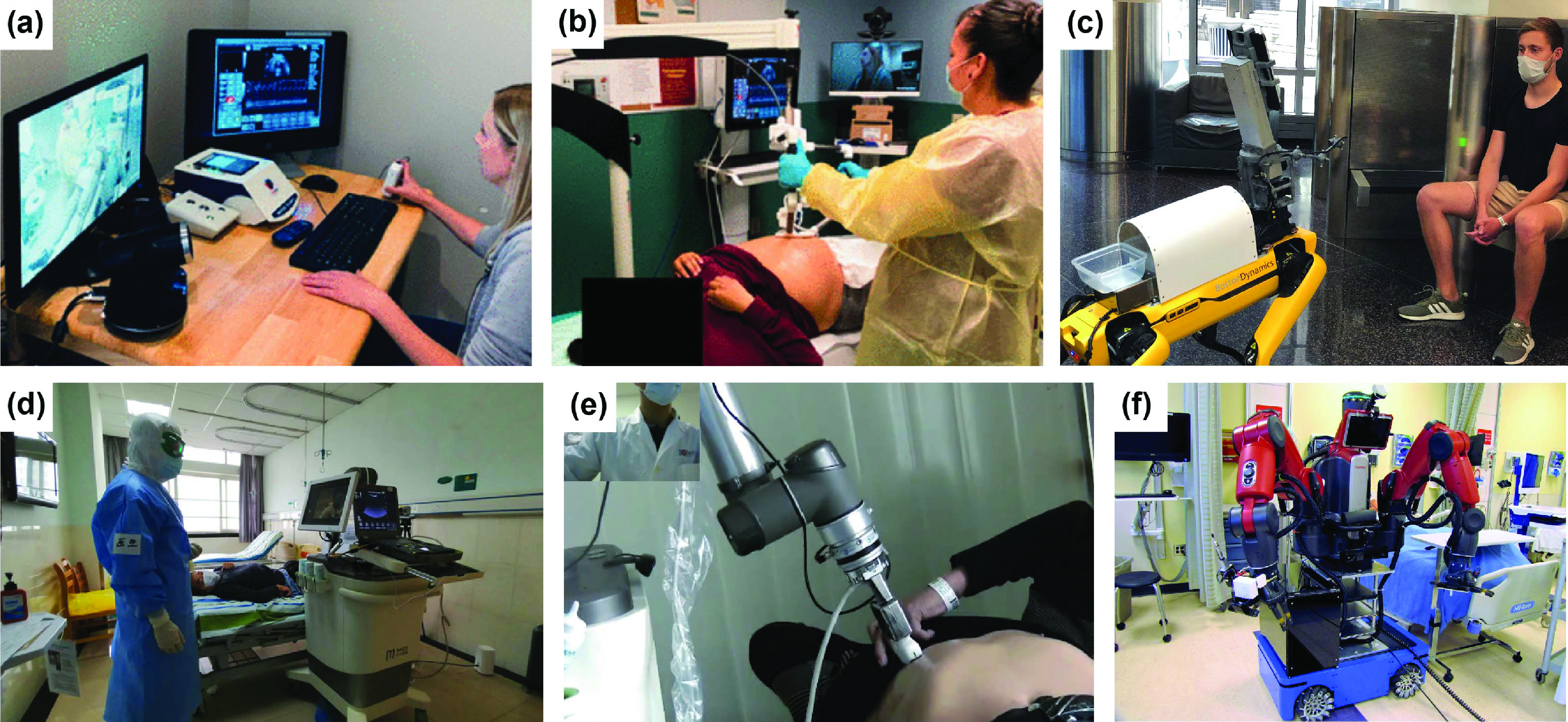
Teleoperated robots used in COVID-19. (a) Sonographer remotely manipulates a telerobotic ultrasound system used in Saskatoon, Canada [111]. (b) At a remote location away from the sonographer, the assistant mimics the movements of the ultrasound [111]. (c) Spot robot from Boston Dynamics being used to triage arriving patients along with remotely collecting vitals [112]. (d) Telerobotic-assisted system performing a lower-limb vein in the examination in Wuhan, China [113]. (e) Performance of robot-assisted teleultrasound based on 5G network [114]. (f) Telenurse TRINA robot (photo credit: the University of Illinois at Urbana-Champaign and Duke University) [49].
Healthcare professionals will often place themselves at risk to complete trivial tasks at the patient’s bedside. Much of the existing medical equipment infrastructure requires that changes be made on the user interface of the device. Although it can be assumed that future equipment will be controlled remotely, the current investments and scale of existing equipment necessitate that providers explore the use of telerobotic systems that allow remote users to manipulate existing equipment [38]. Adding remote functionality to existing equipment would enable hospitals to not only manage costs but quickly adopt new capabilities. These upgrades to existing equipment allow staff to avoid excessive PPE use along with reducing exposure to contagious patients.
Many of the lessons learned in the development of surgical and telepresence robotic platforms can be used to bridge the gap in current telehealth technologies. Incorporating telerobotics with telepresence, autonomous systems can be used to deliver more efficient remote care [19], [71]. By incorporating telerobotics into the existing telehealth infrastructure, healthcare providers could avoid a complete halt of elective medical procedures during future “stay-at-home” orders.
Examples of remote telerobots for diagnosis or even surgical procedures have been around for over 20 years. The ZEUS system (Computer Motion, Galeta, CA) completed a surgical operation with 14,000km between patient and surgeon [115]. Even with the excitement surrounding early development in remote procedures little has be done until now with remote teleprocedures. There are many developments in telerobotics that suggest that telehealth and telerobotics will continue to evolve to a point where full procedures can be completed remotely. Advancements in tactile telerobot show that systems are getting more intuitive to use and improving user performance [116]. Recent studies motivated by current COVID-19 restrictions show the possibility of remote robot-assisted procedures. In [111], the obstetrical ultrasound image is obtained by a sonographer (Fig. 7(a-b)) who operated a ultrasound (US) probe through a telerobot that is 605km away. Ultrasound is an important diagnostic method for patients with COVID-19 and provides important information for treatment strategies. In [113], [114], [117], an MGIUS-R3 robotic tele-echography system [118] is used to conduct a remote US diagnosis. The physician’s side has a console and two imaging monitors to display a live video and the US image; the patient side includes a US device and a 6DOF arm with a force sensor equipped with convex and linear array transducers. Using the above system, a patient could be examined by a doctor that is 700km [113] or even 1479km away [114]. In [119], a gantry-style robotic platform, which has 4 axes at the gantry-style positioning unit and 4 axes at the passive-actuated end-effector, is specifically developed for lung ultrasound. Most of the remote procedures were conducted with the patient and technician in one room while the physician is located in a remote location, as shown in Fig. 7(a-b,d-f). These procedures show that remote robotic assisted procedures are promising in ensuring that patients continue to receive care while ensuring societal safety. Remote telehealth procedures can also be use reduce healthcare disparities in undeserved and rural populations where in-person procedures are either not possible due availability of care or during “stay-at-home” orders [109]. Continuous development in 5G communication technologies shows great strides in enabling remote access for telehealth providers [120].
C. Advantages
The adoption of telehealth was accelerated as the world began to see the full effects of COVID-19. Through telehealth, patients are able to continue to receive medical attention while reducing overall exposure. This reduced exposure carries over to surgical robots where patients see shorter recovery times along with less time in the hospital post-surgery. Receiving the necessary care along with faster recovery times from robotic surgery improves overall treatment outcomes. Robots for telehealth and teleprocedure will keep growing as the world continues to contend with the pandemic.
D. Challenges
In a very short period of time, massive technical and economic strides were taken to bring telehealth to its current state since the onset of COVID-19. Primary challenges to continued rapid growth will be in the capital investment and development cost along with network issues outside of the healthcare facility.
V. Social & Care
During the pandemic, countries worldwide have had to practice social distancing to reduce the spread of COVID-19. Policies of social distancing could result in social isolation, which increases the risk of both psychological and even physical health problems, such as dementia and heart disease [121]. More importantly, as a record number of COVID-19 cases are seen in the U.S. and Europe, there is widespread fear and concern associated with the shortage of healthcare facilities and human resources during the pandemic [122]. This stimulates the demand of using more unmanned systems and robots to share the workload in such environments. In this section on social and care robots, we have reviewed work in both academia and industry that presents solutions to address the issues created by social distancing policies.
A. Social
During the pandemic, the main concerns among people are loneliness and isolation, which are dramatically amplified [123]. A study investigating 195 user experiences of 66 social robots identifies the main roles and functions of social robots during pandemic [51]. They can perform as well-being coaches to help reducing isolation by providing daily guidance and entertainment for the quarantined public. In detail, companion, entertainment and edutainment, medical and well-being adherence, as well as the promotion of physical exercise, are the four main fields that social robots can provide support not only to patients but also the general public under isolation during the pandemic [124].
More specifically, social robots during the pandemic can improve one’s psychological health. Henkel et al. aim to propose research that addresses the general public on how social isolation during COVID-19 is affecting their psychological well-being. The results show that social robots have the potential to uplift consumers’ psychological well-being by acting in four different roles: entertainers, social enablers, mentors, and friends [125]. The pandemic has also brought a burden to autism research [126]. ADOS (Autism Diagnostic Observation Schedule) for people with autism spectrum disorders (ASD) needs a new solution due to social distancing and masks worn by participants.
Another important function of social robots during the pandemic is to help maintain social distance [127]. In [128], a robotic system was proposed to detect pairs of human in a crowded scenario automatically. In their study, an RGB-D camera and 2D lidar are used to navigate the robot and detect the distance between people, as shown in Fig. 8(a). The robot can perform well in both static indoor context (guided by CCTV camera) and dynamic outdoor scenarios. A study showing that COVID-19 can negatively affect the tourism industry discusses the use of service robots to alleviate concerns of patrons. The general idea is that service robots deployed to the tourism industry can provide physical distance and shield between tourists and employees. Despite that, robots can still keep social connectedness and lessen the emotional distance among tourists [129].
FIGURE 8.
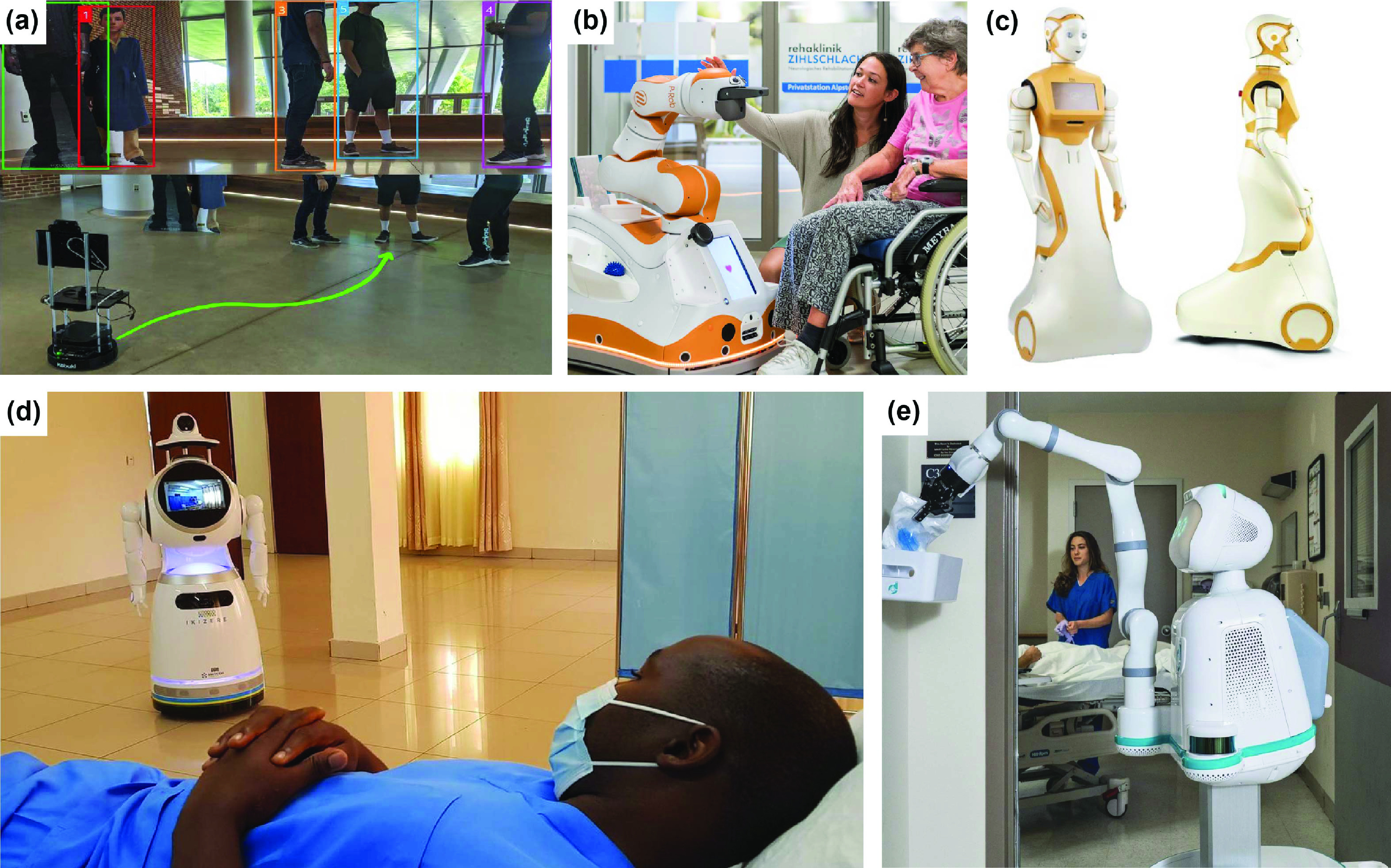
Examples of social and care robots. (a) Social distance monitoring using computer vision and navigation methods (photo credit: Adarsh Jagan Sathyamoorthy) [128]. (b) Lio Robot with HRI features [130]. Patient and staff interacting with Lio in a rehabilitation clinic in Switzerland (photo credit: Justinas Miseikis). (c) ARI (PAL Robotics) Humanoid Robot aims for more effective social interaction (photo credit: Sara Cooper) [73]. (d) Cruzr robot (UBTECH Robotics) checking the temperature of a healthcare worker during the demonstration [131]. (e) Moxi (Diligent Robotics) taking care of patients in a hospital [132].
Rather than just helping people recover from loneliness while keeping social distance, social robots can also supply distance education. Based on a recent study, robot tutors provide three major advantages over a curriculum consisting of just online courses. First, robots can be used for a curriculum that requires engagement with physical learning. Second, they promote more prosocial behaviors. Third, students gain more in learning while interacting with the robots [133]. Another educational robot called Q-Bot (Quarantine robot) is a virtual robot in the form of an interactive e-book story that provides information collected from CDC for best health practices during COVID-19. The Q-Bot is designed mainly for children [134].
Among those functions of social robots, HRI has drawn considerable attention in the research and industrial fields during the pandemic. Studies have been done to optimize social robots for more reliable and human-centered HRI performance during COVID. Lio, an already deployed, personal assistive robot with a multi-functional arm for HRI applications is reported during COVID-19 [135]. The Lio robot is considered as an all-in-one robotic platform with various functions and safety features in the personal care domain [130]. In Fig. 8(b), the Lio robot is interacting with a patient under the staff’s guidance.
The functionality and industrial design of a robot are closely related to the practical user scenarios. Humanoid social robots are the most eye-catching ones in the market. Pepper and Nao from Softbank Robotics, Care-O-bot series from Fraunhofer IPA, TIAGo and ARI from PAL Robotics are some examples of humanoid robots which naturally serve as social robots with functions such as communication, the ability to provide instructions, and physical interaction (with facial expression, head motion, or dancing, etc.) [73]. Specifically, the ARI robot shown in Fig. 8(c) is a mobile and social humanoid robot being developed to ask patients COVID-related questions on the symptoms [136]. On the other hand, social robots can also take the shape of pets that aid in stress relief. Examples include PARO (AIST, Japan), Aibo (Sony, Japan), and iCat (Philips Electronics, Netherlands). Among them, the PARO robot (in the form of a baby harp seal) could help reduce anxiety among the elderly with dementia [73].
Different from other robots, which also play important roles during the pandemic, social robots offer numerous specific and even irreplaceable support to humans, especially the elderly. As technology advancements continue to drive more human-centered studies for social robots, we will see many new and commercial available social robots.
B. Care
Besides social robots, the robots categorized as “care” are primarily used in the healthcare field such as in hospitals for physical assistance with patients. For example, the usage of robots in pandemics such as Ebola, Avian flu, and Severe Acute Respiratory Syndrome (SARS) have demonstrated their capabilities in the healthcare field, including but not limited to clinical care, patient welfare, patent data management, and reducing fomite transmission [137].
Specifically, in the patient care context, Lee et al. propose a pilot study where a chat robot called “Sunshine”, will be developed to help seniors with cognitive dysfunction [138]. Although not at the product level, Sunshine can potentially provide human-like cognitive assistance, communication, and simulated activities by implementing advanced speech recognition and natural language processing algorithms. The Sunshine robot aims to provide an efficient service for the Alzheimer’s Disease and related dementias (ADRD) community in light of the COVID-19 pandemic.
Beyond that of physical assistance, care robots also play critical roles in telemedicine. Amyotrophic Lateral Sclerosis (ALS) is a fast-progressive neurodegenerative disease and a good model to further develop telemedicine [139]. With the new technologies including communication, mobility, environment interaction, and cognitive evaluation deployed in the telemedicine robot, ALS patients could get quality care from robot, which can be in turn improved by the pandemic due to heavily use and plenty of service experience.
Robots applied to a more general-purpose use in the hospital are widely reported to help in combating COVID-19. At the beginning of the pandemic, the Chinese hospital, Hongshan Sports Center in Wuhan city, started to use 14 robots for cleaning, disinfection, and medicine delivery. In India, humanoid robots and three-wheeled robots are deployed in the hospital to free up hands in hospitals for more sophisticated tasks. They assist patients in isolation wards, which greatly limits the spread of the virus [140].
The caregivers working on the frontlines could be greatly relieved by the Cruzr robots made by UBTECH Robotics in China. For example, Hospitals in Rwanda have received donated Cruzr robots for fighting COVID-19 from United Nations Development Programme (UNDP). Those robots are used mainly for checking temperatures and monitoring the healthcare workers and/or patients as displayed in Fig. 8(d). Moreover, according to the workers, the robot could talk to people in the native tongue which shows a considerable advantage in information transfer [131].
In the meantime, robots deployed in a hospital located in Texas, U.S., can perform repetitive chores to save the staff’s time for more important things. Moxi, a robot from Diligent Robotics, has been repurposed with new configurations in respond to the COVID-19 crisis. The primary task for Moxi is delivering consumables across the facility [132]. As shown in Fig. 8(e), the robot is picking up tissue for a patient. On the other side of the hospital, due to the heavy workload in the intensive care unit (ICU), people have re-purposed industrial exoskeletons to help with caregivers in tasks like prone positioning [141].
Compared with social robots, care robots provide more direct help to patients and caregivers in hospitals and other healthcare facilities. As indefatigable “soldiers” in the main battleground of the fight with COVID-19, care robots could greatly support the war with the help of advanced robotic technologies.
C. Advantages
Social and care robots provide many promising ways to assist elderly people and improve the service quality of healthcare providers during and after the pandemic. Compared to the traditional approaches with human labor in both social care and hospital care environments, robots can greatly improve efficiency and quality of service in multiple aspects. First, social robots can provide physical and virtual companionship, communication, and guidance, these features will aid in reducing the risk of virus transmission while serving the primary functions. Second, robots designed in different forms or addressing specific functions could facilitate the aimed tasks efficiently compared to humans. Third, social and care robots can work tirelessly in hospitals during the pandemic. The advantages of social and care robots have greatly expanded during COVID-19 with the help of numerous researchers and healthcare providers whose works are also significantly impacted by COVID-19 [133].
D. Challenges
The COVID-19 pandemic will have a long-last impact on the entire research areas [142]. Specifically, the challenges falling on the social and care robot research areas are apparent. First, the pandemic could affect HRI research greatly, specifically on the human subject-oriented research area. Those research studies require human subjects to perform experiments which can take a year or more to finish, and studies involving tactile or multiparty interactions are currently limited or suspended. The results of the pandemic on the ongoing researches can be detrimental to ongoing and new studies. Ultimately, some research projects might change their directions towards more methodological and/or theoretical [142]. Second, privacy incursion is always a serious issue for electronic devices, including robots working closely with the human. As the information technology being rapidly developed, electronic devices including social and care robots are trying to obtain personal information about users to be shared between commonly used tools and robots. For example, robots in use need to record a users’ voice, face, and body images that can be divulged if they are not appropriately secured [143]. Another challenge people can easily ignore is the potential virus transmission via shared robots with frequent physical human-robot interaction (pHRI). For example, although the robotic pets could help relieve elderly people’s loneliness, as a shared public resource among senior adults they might carry the virus and spread it out [144]. Finally, someone may also argue that robots can easily replace human labor in the elderly care field, causing the loss of experience capacity of human caregivers after the pandemic is over [143]. All of those challenges are still open and under broader discussion even after the robots have been deployed.
VI. Logistics & Manufacturing
A. Logistics
Package delivery, or last-mile logistics, has been mostly suspended during the lockdowns associated with COVID-19. This blocks the movement of supplies and results in the shortage of commodities throughout the supply chains of multiple industries. On the other hand, lockdown measures have driven consumers indoors and online, which results in a surge in demand for delivery services. These are forcing the overloaded logistics industry to evaluate and implement new ways of operation. Additionally, it is difficult for human drivers to operate safely during deliveries and maintain their social distance from customers. Logistic robots have recently started to gain attention due to their efficiency and capacity to meet the demand while reducing people traveling and direct human contact for social distancing. The tremendous market interest has also been pushing logistics robots developers to provide large-scale operations in several U.S. cities [150]. Before COVID-19, the use of robots was rather a novelty than a preferable choice for most consumers. With the onset of this pandemic, autonomous robots are playing critical roles in many activities across logistics around the world [151].
The UDI vans, called Hercules (shown in Fig. 9(e)), were successfully deployed in three cities in China to provide contact-less package transportation [148]. The autonomous vehicle equips a variety of onboard sensors and leverages satellite navigation systems to navigate through narrow street while avoiding an unpredictable mass of pedestrians, bicycles, and trucks. The truck’s neural network models facilities fast identification of different obstacles from 3D point clouds with a rate of 100Hz. It has already run over 1,100km a month during the COVID-19 outbreak. A remote driving system through the 4G/5G technology serves as a backup strategy due to safety concerns [152]. Although it is possible for consistent delivery tasks in some scenarios, it is challenging to handle automated delivery in all possible realistic environments. That being said, lockdowns result in relatively empty street that safely allows the implementations of current state-of-the-art delivery systems. Neolix, a maker of urban robo-delivery trucks, designed its trucks to choose delivery routes that consist of public roads with little traffic. During the pandemic, this strategy allowed the tucks to finish 200 orders in two months, compared to 159 orders eight months before [153]. Amazon has also put delivery robots Scout (see Fig. 9(a)) to work during the pandemic and is expanding tests in areas where human delivery staff might be vulnerable to COVID-19 [154]. Likewise, Pony, a self-driving car startup, is using its autonomous car, shown in Fig. 9(d), to deliver packages with 200 items a day in California, U.S.
FIGURE 9.
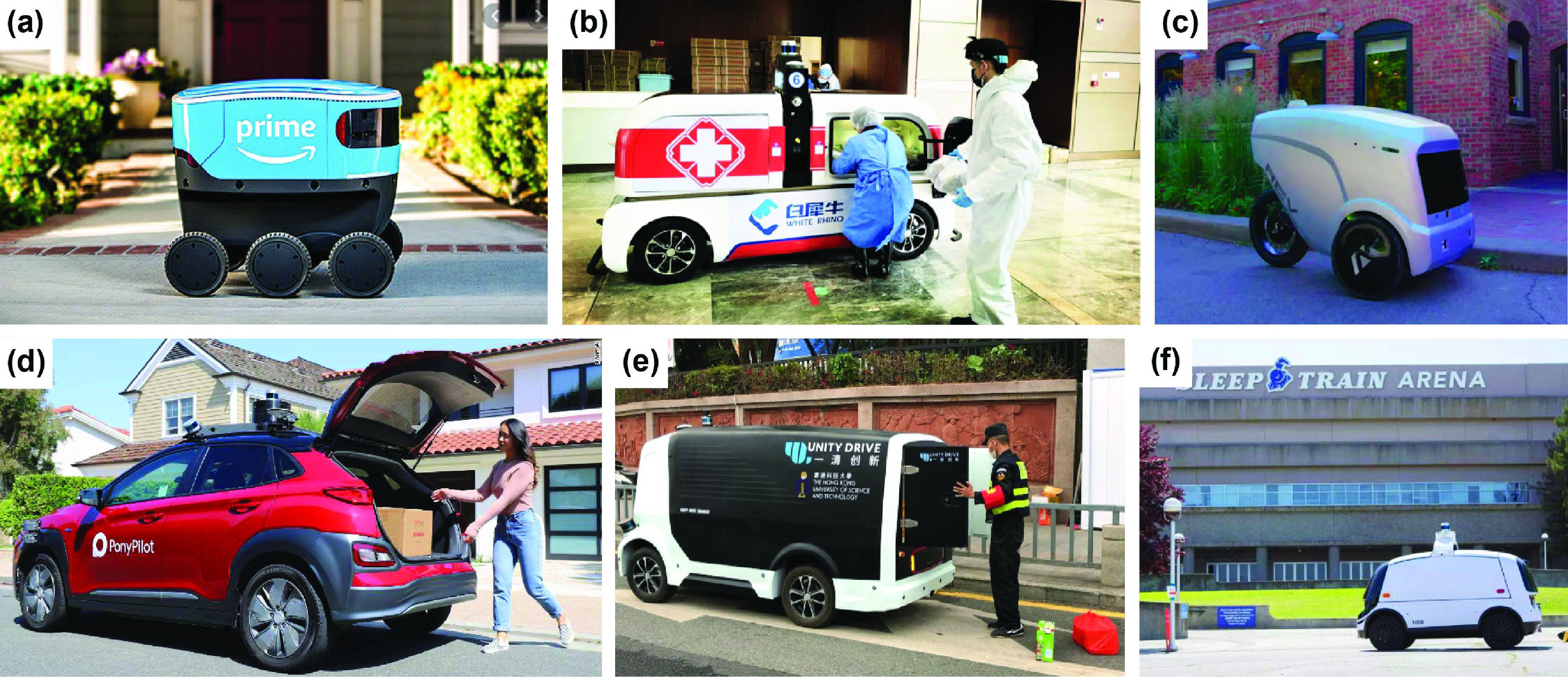
Autonomous ground vehicles for delivery. (a) Scout, the delivery robot (photo credit: Amazon, Inc.) (b) White Rhino delivery robot in Wuhan, China (photo credit: White Rhino, Inc.) [145]. (c) The REV-1 robot in Ann Arbor, Michigan (photo credit: Refraction AI) [146]. (d) The Pony.ai delivery service using self-driving cars in California (photo credit: Pony.ai) [147]. (e) UDI self-driving vehicle, Hercules, delivering lunch boxes to workers in Shenzhen, China (photo credit: UDI) [148]. (f) Nuro ferrying medical supplies to a makeshift medical facility in California (photo credit: Nuro, Inc.) [149].
Drones can transport cargo over rough and complex terrain and are generally much more rapid and more efficient than such tasks with ground vehicles [155]. Drone deliveries have started to gain more and more attention during this pandemic [45]. To facilitate a wider implementation of autonomous aerial delivery, the Federal Aviation Administration (FAA) granted drone flight waivers to help fight the COVID-19 pandemic [156]. For example, Amazon received approval to deliver packages by drones [157]. Alphabet’s drone delivery company Wing (Fig. 10(a)) has made over 1,000 deliveries of groceries in two weeks in the U.S. and Australia [158]. Customers must have their meals delivered because dining-in is not an option. The UK government granted 8 million pounds for testing drones and evaluating the feasibility of aerial deliver in the future [146]. In Ann Arbor, Michigan, eight self-driving REV-1 robots that resemble bicycles (shown in Fig. 9(c)) from the startup Refraction AI are making 100 lunch deliveries daily [159].
FIGURE 10.
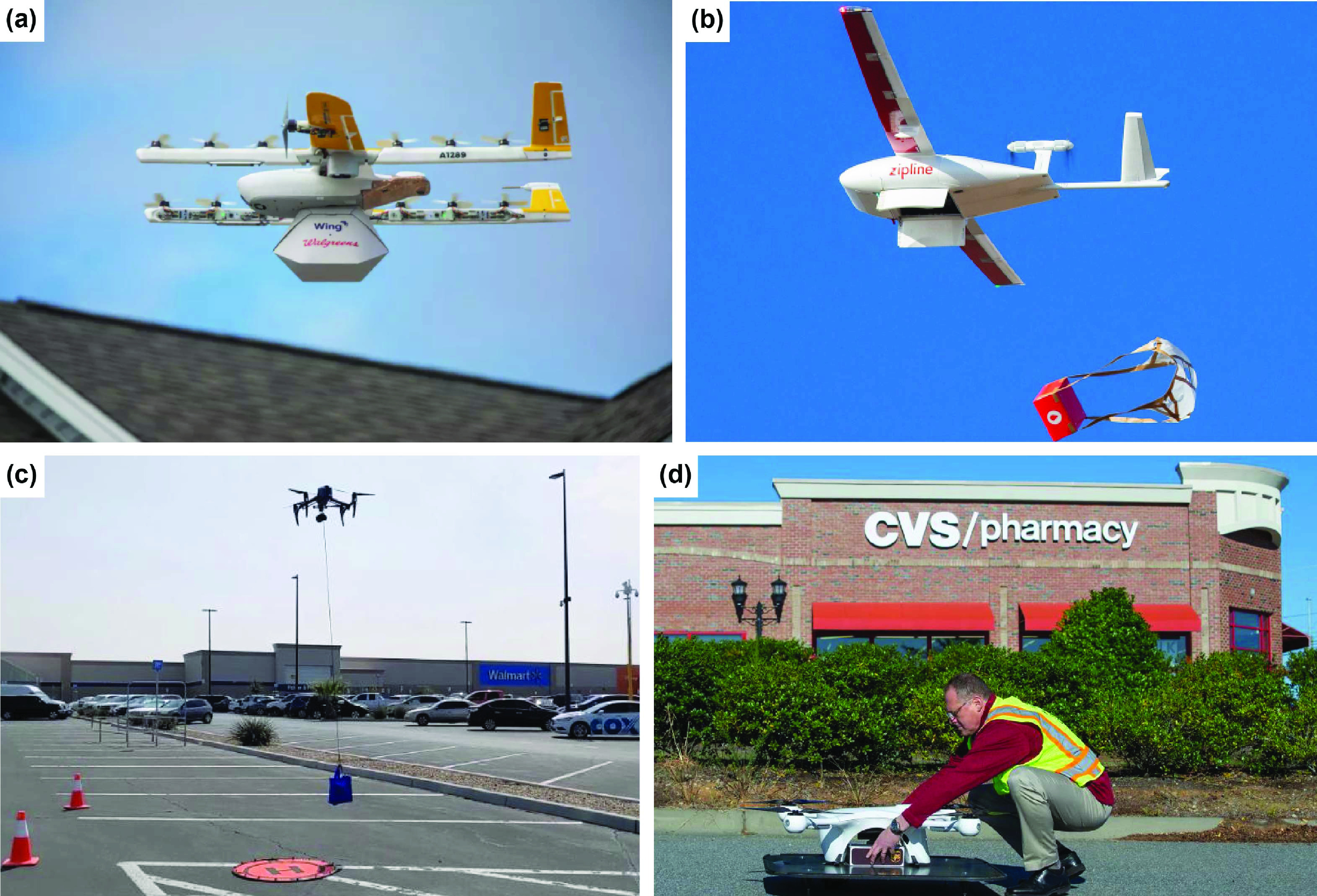
Autonomous drones for delivery. (a) Wing delivery drone (photo credit: Wing, Inc.) [158]. (b) Zipline delivery drone (photo credit: Zipline, Inc.) [160]. (c) Walmart’s pilot drone delivery program in Las Vegas, U.S., transporting COVID-19 tests (photo credit: Walmart, Inc.) [161]. (d) UPS has launched two healthcare-related drone delivery trials during the pandemic (photo credit: UPS, Inc.) [162].
Autonomous delivery of medical stuff reduces human involvement in the medical supplies, which decreases the clinic and pharmacy overcrowding by making it more practical for non-urgent patients to receive care in local clinics closer to home [160]. The White Rhino Auto company proposed an unmanned vehicle, as shown in Fig. 9(b), to transport medical supplies for doctors and patients in Wuhan’s Guanggu Field Hospital [145]. Nuro company is using its small fleet of road-legal delivery robots, as presented in Fig. 9(f), to transport medical supplies around two stadiums that have been converted into treatment facilities for people stricken with COVID-19 in California, U.S. [149]. A drone invented by a California-based startup Volansi, Inc., has been used to deliver medicines and vaccines from a Merck manufacturing facility in North Carolina to a nearby healthcare clinic [163]. It demonstrates that the use of a drone could streamline the operations and cut costs across distribution networks. The Italian company Elite Consulting started the transport of swabs and small medicines with the DJI Matrice 200 series drone equipped with a specially designed box preventing the leak of biological material [164]. Walmart launched a pilot drone delivery program that drops off COVID-19 tests to homes nearby the North Las Vegas store in September 2020 [161] (see Fig. 10(c)). Zipline, a California-based drone-delivery startup, delivers critical medical supplies such as masks, test samples, and blood products in Ghana [165] and Rwanda [160] (see Fig. 10(b)). UPS has launched healthcare-related trials during the pandemic to deliver prescription medication from a nearby CVS in Florida and to offers fast shipping of time-sensitive medical supplies and PPE in North Carolina, U.S. [162] (see Fig. 10(d)). Furthermore, in hospital, to avoid the spread of disease within hospitals and to preserve the health of medical staff and patients, autonomous mobile robots were used for drug distribution [166]. Diligent Robotics deployed the commercial mobile manipulator, Moxi, to respond to COVID-19 crisis by picking supplies out of supply closets and delivering them to patient rooms in healthcare [132]. Overall, robotic delivery has been shown to be a useful alternative to human labor.
On the other hand, in warehouses drones have been actively applied to expedite inventory counting, optimize routes around a warehouse when pulling inventory, and improve the staff safety [167]. For example, the Ware, a California-based technology company, launched its first warehouse inventory automation system built on Skydio 2 quadrotors [168].
B. Manufacturing
The distance between workers in factory and contact with contaminated surfaces are listed as restrictions to follow by the U.S. Centers for Disease Control and Prevention (CDC) to reduce workers’ risk for exposure to the novel coronavirus. The health and safety of workers are still two of the biggest concerns after the factories coming back online. Collaborative robots, or “cobots” in short, on a production line are able to operate safely within close proximity to humans and help their human coworkers maintain social distance. Here are some examples.
GE Healthcare partnered with Midwest Engineered Systems (MWES) are integrating Universal Robots (UR) robots on assembly lines to help fabricate consumables for ventilators. Robotic palletizing and depalletizing with a FANUC robot in MWES, as shown in Fig. 11(a), also get increased throughput while practicing social distancing at the same time. Mobile robots like [169] and inVia Robotics [170] promote social distancing by delivering parts to assembly lines, transporting work-in-process (WIP), and managing material handling in warehouses [171]. Automation of factory floor movement improves process flow and reduces turnaround time for product processing without personnel intervention. The automated processing line allows automated sterilization and disinfection to eliminate the risk of foreign contaminants. The remote controlling and monitoring of the manufacturing through the automated systems also negate the need for personnel presence [172].
FIGURE 11.
Robots in manufacturing. (a) Robotic palletizing system for servicing multiple conveyor lines and promoting social distancing among manual labor (photo credit: Midwest Engineered Systems, Inc.) [171]. (b) Robotic arms processing raw lamb on the meatpacking line (photo credit: SCOTT Automation).
In the meat processing industry, with dozens of slaughterhouses closed or cutting back operations, meat shortages have happened in both Europe and the U.S. Robots in some slaughterhouses have been taking over works in Europe. Meatpacking robots allow packing workers working virtually shoulder-to-shoulder on assembly lines without exposing workers to bone-chilling temperatures and the danger of sharp tools [173] (see Fig. 11(b)).
After the outbreak of COVID-19, healthcare facilities around the world found themselves in short supplies of PPE, such as masks, face shield visors, and protective clothing. Fortunately, many researchers and companies stepped up and began leveraging robotic production techniques to quickly manufacture the needed goods. For example, researchers at the Queen Mary University of London teamed up to produce reusable visors using 3D printers and already delivered more than 1,500 visors. DOF Robotics, a producer of dynamic simulation platforms, has joined the fight against COVID-19 by manufacturing PPE, too [174]. While a large number of human workers are still needed to produce sufficient PPE to meet the demand, players in traditional industries such as the automobile manufacturers who have deployed robots in manufacturing for decades could be leveraged and partially repurposed. For example, vast robot-assisted automated PPE manufacturing lines have been created by BYD and Foxconn [175]. A model for faster integration of cobots and design guidelines for workstations to ramp up ventilator production while maintaining social distancing is provided in [176].
C. Advantages
There are numerous advantages of autonomous logistic robots over traditional approach with human labor in this pandemic. To reduce human labor cost in supply chains, robots in the warehouses avoid cross-infection, increase order accuracy and productivity, cut down on workplace injuries, reduce mistakes, and shorten downtime due to inventory checks [167], [177]. Delivery robots allow lower costs for the client and the consumer, decreased traffic congestion, lower emissions, and total visibility throughout the entire journey [178]. Transport by drone is 8 to 12 times faster than ground vehicles and virtually noiseless [179]. As new lockdown periods took hold in the latter part of the pandemic, many countries turned to aerial delivery in order to keep people safe [66], [180]. This pandemic may also lead top retailers like Amazon and Walmart to accelerate automation to lessen their dependence on human labor [181]. Cobots in the manufacturing industry eliminate repetitive tasks for workers. Cobots with flexible software could easily switch into different function modes and cobots with arm attachments can have their arms easily adapted to various tasks. This modularity allows the robot’s repurposing from one task to another in a way that other robots cannot do [182]. Cobots also ensure a safer work environment since they are designed with high priority of safe human-robot interaction like active collision avoidance [183].
D. Challenges
Autonomous mobile robots in the warehouses move slowly for safety reasons, are better for lightweight tasks, have intense demands on the area of use. Although sidewalk robots, self-driving cars, and drones have been already tested for deliveries in at least six states in the U.S., they only count for a tiny fraction of goods delivered. Ground robots are commonly expensive due to the high costs of sensors such as 3D lidar and processor. They cannot autonomously move safely in busy streets or communities hampered by some technical bottlenecks of perception and localization. Humans have to supervise the robots to prevent mistakes and help them out of some confusing situations [184]. The higher risk of malfunction blocks the wider application of drones during delivery operations, with their battery life shortened. Presently, drones are not able to fly in heavy rain or in extreme wind, have limited battery capacity, and significantly rely on satellite-based positioning systems for trajectory tracking [185]. Variability is one of the biggest challenges of cobots in workspaces. Some variation in environment and tasks are minor for humans but can be a major problem for cobots’ repeatability.
VII. Other Robots
The COVID-19 pandemic is having a significant impact on almost every industry in human society. In addition to the industries and application fields discussed above, other industries and fields have also seen new robots emerged or existing robots repurposed, albeit of a smaller number, to fight the COVID-19 pandemic. These robots will be discussed below, together with their advantages and current challenges. It is believed that many of these new ways will remain post-pandemic for further development since this public health crisis has not only motivated people to start these innovative approaches but also changed the way people think.
A. Agriculture
This pandemic has had a sharp effect on agricultural activities, causing labor shortages as well as disrupting the agro-food supply chain [186], [187]. It has been mentioned [188] that the COVID-19 pandemic may speed up the adoption of agricultural robots to pick fruits and vegetables in Europe, as the COVID-19 crisis has dramatically affected the ability of migrant seasonal workers to travel. Research and Markets published an article on the robotics industry, entitled “Agricultural Robots: A Growing Trend Amid COVID-19” [189], where they discuss broader impacts of this pandemic on the agricultural sector.
Since the COVID-19, agricultural robots maker Root A.I. has expedited the launch of some of its newest technologies to a series of agricultural customers in the U.S. and Canada. One of these products is a fruit-picking gripper, which mimics the natural ability of the human hand’s gripping and twisting motion [190]. Also, a tomato-harvesting robot and a robot that is able to precisely spray pesticide have been shown as solutions to save labor and curb the issue of social distancing [191]. The need for robots due to labor shortage and social distancing may be temporary, but the use of robots for harvesting is possibly the most promising proposal within the next five to ten years. COVID-19 has motivated farmers to reconsider their production methods and will likely stimulate the continual development and application of these kinds of robots post-pandemic.
The challenges for broader deployment of robots in harvesting include: 1) uncertainty in the robots’ effectiveness; and 2) a significant increase in initial production costs. Nevertheless, these costs will likely be offset by continued investment and development.
B. Security
In the security industry, robots allow facilities to maintain security operations, while not exposing patrolling security guards to the dangers of inter-person spread of the SARS-CoV-2 virus [192]. In Spring 2020, SMP Robotics Systems Corp., a robotics company in California, U.S., deployed their proprietary security robot in outdoor protection and monitoring roles, along with human security officers. The robot (Fig. 12(a)) is fitted with surveillance and thermal cameras which work in fully autonomous mode, constantly patrolling while officers monitor from a dispatch center [192]. Outside of the U.S., this robot has been deployed in areas such as at Abu Dhabi’s largest mall to help keep shoppers safe throughout the day and the night. Introducing robotic security was one of many measures taken by the mall’s management to combat the spread of COVID-19 among its patrons [64]. Police in Tunisia is also using security robots to patrol streets and to enforce lockdowns related to COVID-19 [193].
FIGURE 12.
Security robots used in COVID-19. (a) Outdoor protection and monitoring during the COVID-19 pandemic (photo credit: SMP Robotics System Corp.) [192]. (b) Knightscope providing COVID-19 Public Safety Announcements Feature (photo credit: Knightscope, Inc.) [196].
Security robots are autonomous and may come equipped with cameras and analytic systems. These robots are, by their nature, effective at providing security and surveillance through regular public patrols. Moreover, the design of many security robots made them ideal candidates to take on the role of public healthcare [194]. Many security robot makers have quickly repurposed or added new public safety features such as non-mask detection, social distance detection/alert and public safety announcement, to their existing robot products, including Cobalt robot [195], Knightscope (Fig. 12(b)) [196], P-Guard [197], etc. It has been reported that drones outfitted with speakers and cameras are creatively deployed by local police department for usage of getting an announcement out to a large area without getting police officers involved to communicate with vulnerable populations such as the homeless [198] or to prevent crowd gathering [199]. In addition, many other new drones have also emerged or existing drones have been repurposed with these features to encourage physical distancing and mask wearing during the COVID-19 pandemic [200]–[202].
Some challenges for security robots to be widely deployed are: 1) maintaining human safety in public areas where the robots operate, e.g., avoiding collisions with pedestrians in crowded areas; and 2) improving users’ overall experience throughout the human-robot interaction, since the mindset of a human interacting with a security robot is patently different.
C. Construction
The COVID-19 pandemic deepened the labor shortage of the construction industry that was already struggling with labor shortages before the pandemic [203]. According to Market Research Future Reports (MRFR), COVID-19 impacted the construction Robot Market 2020 with some primary factors, such as lack of workforce, and adoption of automation/robots by construction companies [204].
A promising new construction robot, Boston Dynamics’ Spot, demonstrated potential for this technology during a recent event at HITT Contracting’s Co|Lab construction research facility in Virginia, U.S. For the Co|Lab demonstration, Spot was fitted with image-capturing technology. While data capture may be the extent of Spot’s capabilities at the current state, it has been said the best use of the robot could be in places in construction that are unsafe for humans [203].
Drones can maintain a safe social distance for everyone involved while helping with the inspection-related construction tasks such as grading, earthwork, site surveys, breaking ground, security, progress monitoring, and identifying hazards [205]. Falcon Eye Drones (FEDS), a drone company in the Middle East and Africa region, reported that real estate developers in the Gulf Cooperation Council (GCC) are turning to drones in post-COVID-19 because the drone can cut project value costs by up to 11.8% and can decrease the time spent to compile the snag list by 32% and the drone helped construction companies increase their reporting turnaround by 25% while cutting down site time wastage by 18.4% [206].
The advantages of adopting construction robots include improvement in safety, quality, and productivity. Many types of construction robots are already ready to perform various construction-related activities and tasks in the current construction market. This is especially true for 3D printing, where construction robots, and their combination with various industrial robots, have already grown to be preferred within the industry.
On the other hand, the challenges of widely deploying construction robots into practice include: 1) the high cost to adopt and maintain the required technology; 2) the barbarous and undefined surroundings of real-world construction sites, which will inevitably create difficulties for robots to accurately perceive hazards and safely navigate.
D. Other Hospital Applications
We also found several other robotic applications in the hospital setting, but neither belong to Part IV nor Part V. We would like to include them to provide a different view angle to the readers.
1). Autopsy
It has been reported that researchers developed an autopsy equipment/robot that provides safety against COVID-19 and other airborne infections, since any virus in a dead patient’s body may change the corpse into hazardous materials. The prototype of its manipulator consists of linear actuator motors, a gearbox with DC gear motor, and several other motors.
The challenge of this application is how to design the control system to make it function as smoothly as a hand control or with the sensitivity of more refined IoT [207].
2). Orthodontics
It has been reported that orthodontics robots may minimize the transmission risk of the SARS-CoV-2 virus from person to person, thereby protecting orthodontists and their patients during regular procedures [208].
VIII. Summary
The unexpected COVID-19 pandemic and its associated lockdowns have had significant - and mostly negative - impacts on human society. Healthcare systems have been put under tremendous pressure, and traditional, direct human labor has faced enormous challenges due to the high contagiousness and infection fatality rate of the SARS-CoV-2 virus. While the difficulties have been presented in almost every industry, robotic systems’ acceptability has increased and many opportunities have been found and followed by robotics developers [209].
In this paper, we discussed several new robots and several robots that have been repurposed, in categories including diagnosis, screening, disinfection, surgery, telehealth, social, care, logistics, manufacturing. While many technical challenges remain unsolved, and some key components are still expensive, robotic systems’ advantages over traditional, direct human labor have been well-utilized by developers and show great potential in the market. For example, as the adoption of mobile robots grows, the demand for related hardware, such as active binocular 3D cameras, ultrasonic sensors and software such as fleet management solutions and cloud services, also rises. It is very likely that the robotics industry’s progress and growth brought on COVID-19 will continue even after the pandemic has subsided.
According to a study from the International Data Corp., worldwide spending on robotics systems is forecasted to reach $112.4 billion by the end of 2020 [151]. Besides those in high-level robotic system applications, we expect more emerging developments and breakthroughs in infrastructure like 5G communication and IoT, as well as core techniques like VR/AR, haptics, and teleoperation. We hope that the insights provided in this review could help new developments of robots in combating COVID-19 and with future unexpected events.
Biographies

Yang Shen (Member, IEEE) received the B.Sc. degree in mechanical engineering and automation from Shanghai Jiao Tong University, in 2013, the B.Eng. (Hons.) degree in mechanical engineering from the University of Hong Kong, in 2013, and the Ph.D. degree in mechanical engineering from the University of California Los Angeles (UCLA), Los Angeles, CA, USA, in 2019.
In 2018, he was a Robotics Software Engineering Intern at Seismic, Inc., aka SuperFlex at SRI International, Menlo Park, CA, USA. In 2019, he served as an Associate Editor for the Wearable Robotics Association Conference, Scottsdale, AZ, USA. He is currently a Research Engineer with the UBTECH North America Research and Development Center, Pasadena, CA, USA. His research interests include physical human-robot interaction, robotic control, exoskeleton, and rehabilitation robotics. He has authored four book chapters, five patents, and multiple journal and conference papers.

Dejun Guo (Member, IEEE) received the B.E. degree in control engineering from Northwestern Polytechnical University, Xi’an, China, in 2012, the M.S. degree in automation from Shanghai Jiao Tong University, Shanghai, China, in 2015, and the Ph.D. degree in mechanical engineering from the University of Utah, Salt Lake City, UT, USA, in 2019.
From 2012 to 2015, he was a Research Assistant to Dr. Weidong Chen and Dr. Hesheng Wang at Shanghai Jiao Tong University. From 2015 to 2019, he was a Research Assistant to Dr. Kam K. Leang at the University of Utah. He is currently a Senior Engineer with the UBTECH Robotics North America Research and Development Center, Pasadena, CA, USA, where he is focusing on the navigation and control of service robots. He is the author of more than 10 research articles. His research interests include visual servoing, autonomous vehicles, aerial robots, and nanopositioning systems.
Dr. Guo was a recipient of the ASME Dynamic Systems and Control Conference (DSCC) Best Student Paper Award in 2017 and the Outstanding Robotics Graduate Student of the Year Award from the University of Utah in 2018.

Fei Long received the B.S. degree from the Department of Mechanical Engineering, Shanghai Jiao Tong University, Shanghai, China, in 2009, and the Ph.D. degree from the Department of Mechanical and Aerospace Engineering, The Ohio State University, Columbus (OSU), OH, USA, in 2016.
In 2009, he was awarded the University Fellowship from OSU, where he was a Research Assistant at the Precision Measurement and Control Laboratory until 2016. From 2016 to 2019, he worked at Nihon Kohden America as a Control System Engineer. From 2019 to 2020, he worked as a Robotics Engineer in THINK Surgical, where he worked on the motion control of the orthopedics surgical robot. He is currently a Staff Engineer at the UBTECH Robotics North America Research and Development Center, where he is leading the Research and Development of the mobile manipulator project. His research interests include robot motion control, motion planning, electro-mechanical system’s modeling, control, and sensing.

Luis A. Mateos (Member, IEEE) received the M.S. degree in computer vision and robotics (ViBot) from Heriot-Watt University and the Ph.D. degree in electrical engineering from the Vienna University of Technology for his robotic solution to inspect and repair old freshwater pipes in the city of Vienna, Austria. For this achievement, he was awarded the 2014 OVE Prize by the Austrian Government.
As a Researcher in the Italian Institute of Technology (IIT), he was developing an industrial exoskeleton “Robomate” to assist workers in automobile factories for carrying heavyweights, intending to prevent back injuries. Similarly, during his stay at the Massachusetts Institute of Technology (MIT), he developed autonomous robotic boats able to self-assembly, perform multi-robot formations, monitor the environment, and transport persons and goods. Since 2019, he has been a part of the UBTECH Robotics, developing the new generation of healthcare technologies. His research interests are in particle robotics and reconfigurable mechatronics coupled with AI capabilities.

Houzhu Ding (Member, IEEE) received the B.Sc. degree in mechanical engineering and automation from the University of Science and Technology of China, Hefei, China, in 2014, and the Ph.D. degree in mechanical engineering from the Stevens Institute of Technology, Hoboken, NJ, USA, in 2019.
From 2014 to 2019, he was a Research Assistant to Dr. Robert C. Chang with the BMBM Laboratory, Department of Mechanical Engineering, Stevens Institute of Technology. Since December 2019, he joined the UBTECH North America Research and Development Center, Pasadena, CA, USA, as a Senior Engineer, to continue his research in robotics. His research interests are the design and automation of robots, mechatronics, visual guided 3D printing, visual servo, and human-robot-interaction.
Dr. Ding was and a recipient of the James H. Potter Award from the Department of Mechanical Engineering, Stevens Institue of Technology, for the Ph.D. graduate with outstanding performance in 2020. He was also an author of 10 journal publications and six conference proceedings and three invention disclosures with one granted.

Zhen Xiu received the M.S. degree in mechatronics engineering from the Beijing Institute of Technology, China, in 2004, the Ph.D. degree in mechanical and control engineering from the Tokyo Institute of Technology, Japan, in 2009, and the M.B.A. degree from the University of California, San Diego, CA, USA, in 2017. He has worked as a Scientist with the Intelligent System Lab, SECOM Company, Ltd., Japan, a Program Manager in Cisco Systems, Inc., and a Product Manager in Hikvision USA Inc. He has also been an Entrepreneur, co-founding a startup in San Diego. He is currently a Senior Product Manager at the UBTECH North America Research and Development Center. His experience and interests include healthcare robot, logistic AGV, machine vision, surveillance systems, thermal camera, industrial drone, and access control systems.

Randall B. Hellman (Member, IEEE) received the B.S. degree in mechanical engineering from Purdue University, and the M.S. and Ph.D. degrees in mechanical engineering from Arizona State University, in 2008 and 2016, respectively. He has worked with multiple robotic startup companies most recently in the surgical robotic field developing novel interfaces for the surgeon to control the robotic instruments. He is currently a Staff Mechatronics Engineer with UBTECH North American Research and Development Center. His research interests include artificial haptic perception, decision-making, reinforcement learning, manipulation, robotic hands, tactile sensors, and haptic interfaces for sensory feedback.

Adam King received the M.A. degree in linguistics from UCLA and the M.S. degree in human language technology and Ph.D. in linguistics from the University of Arizona, where he researched how the languages of the world evolve to be efficient communication systems.
During his time at the University of Arizona, he was awarded a Graduate Research Fellowship from the NSF (NSF-GRFP) and was involved in several research projects in both computational linguistics and psycholinguistics, resulting in publications in journals such as Language and OpenMind. He joined UBTECH Robotics in 2020 and is currently involved in the development of spoken dialog systems for multiple robots.

Shixun Chen received the B.E. degree in vehicle engineering from Tsinghua University, Beijing, in 2016, the B.A. degree in design for a second degree from Tsinghua University, Beijing, in 2016, and the M.S. degree in industrial design from the ArtCenter College of Design, CA, USA, in 2019.
In 2020, she served as a Design Coach for Executive Education Online Programme Design Thinking and Creativity for Business at INSEAD, Fontainebleau, France. She is currently an Industrial Designer at the UBTECH North America Research and Development Center, Pasadena, CA, USA. She works in the area of product design, service design, and UI/UX design.

Chengkun Zhang (Member, IEEE) received the B.S. degree in mechanical engineering from Jilin University, Changchun, China, in 2005, the M.S. degree in automation from the Beijing University of Posts and Telecommunications, Beijing, China, in 2008, and the Ph.D. degree in mechanical engineering from the University of Delaware, Newark, DE, USA, in 2013.
From 2009 to 2012, he was a Research Assistant to Dr. Sunil Agrawal in the ROAR Laboratory with the Mechanical Engineering Department, University of Delaware. From 2013 to 2019, he was a Mechanical Engineer in the Mechanics and System Organization with the GE Global Research Center and primarily supported GE Healthcare. He has been with UBTECH NARDC since March 2019 to continue his research in the robotics and mechatronics fields and contribute to the fulfillment of the UBTECH dream - Bringing A Robot into Every Home and Business. He is an author of 10 journal and conference publications and more than 30 invention disclosures with six granted.

Huan Tan (Senior Member, IEEE) received the B.E. degree in automation from Tianjin University, Tianjin, China, in 2003, the M.E. degree in computer applied technology from Nankai University, Tianjin, China, in 2006, and the Ph.D. degree in electrical engineering from Vanderbilt University, Nashville, TN, USA, in 2013.
From 2006 to 2008, he was an Engineer with the Graduate School at Shenzhen, Tsinghua University. From 2013 to 2018, he was a Research Scientist with the Global Research Center, General Electric Company. Since 2018, he has been with UBTECH Robotics Corp. Ltd., as the Vice President and got promoted to the Co-Chief Technology Officer in 2019. He is the author of three books, more than 40 research articles, and more than 100 inventions. His research interests include visual servo manipulation, cognitive control, human-robot interaction, robot learning, motion planning and control, automated task planning, and healthcare robotics.
Dr. Tan was a recipient of the IEEE Region 1 Technological Innovation Award in 2018, GE Inventor Gold Medallion in 2018, GE SSA Early Career Award in 2015, and GE Above & Beyond Gold Award in 2015. He is an Associate Editor for the IEEE International Conference on Robot and Human Interactive Communication, and an Associate Editor for the CAAI Transaction on Intelligent Technology.
References
- [1].Gates B., “Responding to Covid-19—A once-in-a-century pandemic?” New England J. Med., vol. 382, no. 18, pp. 1677–1679, Apr. 2020. [Online]. Available: http://www.nejm.org/doi/10.1056/NEJMp2003762 [DOI] [PubMed] [Google Scholar]
- [2].Sohrabi C., Alsafi Z., O’Neill N., Khan M., Kerwan A., Al-Jabir A., Iosifidis C., and Agha R., “World health organization declares global emergency: A review of the 2019 novel coronavirus (COVID-19),” Int. J. Surg., vol. 76, pp. 71–76, Apr. 2020, doi: 10.1016/j.ijsu.2020.02.034. [DOI] [PMC free article] [PubMed] [Google Scholar]
- [3].Thorp H. H., “A dangerous rush for vaccines,” Science, vol. 369, no. 6506, p. 885, 2020. [DOI] [PubMed] [Google Scholar]
- [4].Barfoot T., Burgner-Kahrs J., Diller E., Garg A., Goldenberg A., Kelly J., Liu X., Naguib H., Nejat G., Schoellig A., Shkurti F., Siegel H., Sun Y., and Waslander S., “Making sense of the robotized pandemic response: A comparison of Global and Canadian robot deployments and success factors,” Robot. Inst., Univ. Toronto, Toronto, ON, Canada, Tech. Rep., Sep. 2020, p. 101. [Online]. Available: https://arxiv.org/abs/2009.08577 [Google Scholar]
- [5].Can AI and Automation Deliver a COVID-19 Antiviral While It Still Matters?–IEEE Spectrum. Accessed: Nov. 7, 2020. [Online]. Available: https://spectrum.ieee.org/artificial-intelligence/medical-ai/can-ai-and -automation-deliver-a-covid19-antiviral-while-it-still-matters
- [6].IEEE Foundation Funds Two Projects to Help Communities Weather the Pandemic–IEEE Spectrum. Accessed: Nov. 7, 2020. [Online]. Available: https://spectrum.ieee.org/news-from-around-ieee/the-institute/ieee-news/ieee-foundation-funds-two-projects-to-help-communities-weather-the-pandemic
- [7].IEEE Foundation COVID-19 Fund Supports Five Programs–IEEE Spectrum. Accessed: Nov. 7, 2020. [Online]. Available: https://spectrum.ieee.org/the-institute/ieee-news/ieee-foundation-covid19-fund-supports-five-programs
- [8].How Roboticists (and Robots) Have Been Working from Home–IEEE Spectrum. Accessed: Nov. 7, 2020. [Online]. Available: https://spectrum.ieee.org/automaton/robotics/home-robots/how-roboticists-and-robots-have-been-working-from-home
- [9].Baig A., Hall B., Jenkins P., Lamarre E., and McCarthy B., The COVID-19 Recovery Will be Digital: A Plan for the First 90 Days. New York, NY, USA: McKinsey & Company, May 2020, pp. 1–8. [Google Scholar]
- [10].Rapid, Affordable, High Quality COVID Tests Still Scant–IEEE Spectrum. Accessed: Nov. 7, 2020. [Online]. Available: https://spectrum.ieee.org/the-human-os/biomedical/diagnostics/rapid-affordable-high-quality-covid-tests-still-scant
- [11].Fazio M., Buzachis A., Galletta A., Celesti A., and Villari M., “A proximity-based indoor navigation system tackling the COVID-19 social distancing measures,” in Proc. IEEE Symp. Comput. Commun. (ISCC), Rennes, France, Jul. 2020, pp. 1–6. [Google Scholar]
- [12].Fan T., Chen Z., Zhao X., Liang J., Shen C., Manocha D., Pan J., and Zhang W., “Autonomous social distancing in urban environments using a quadruped robot,” 2020, arXiv:2008.08889. [Online]. Available: http://arxiv.org/abs/2008.08889
- [13].Serrano F. and Kazda A., “The future of airports post COVID-19,” J. Air Transp. Manage., vol. 89, Oct. 2020, Art. no. 101900. [Online]. Available: https://linkinghub.elsevier.com/retrieve/pii/S0969699720304841 [DOI] [PMC free article] [PubMed] [Google Scholar]
- [14].Donovan N. J., Wu Q., Rentz D. M., Sperling R. A., Marshall G. A., and Glymour M. M., “Loneliness, depression and cognitive function in older U.S. adults,” Int. J. Geriatric Psychiatry, vol. 32, no. 5, pp. 564–573, May 2017. [DOI] [PMC free article] [PubMed] [Google Scholar]
- [15].Zaniboni A., Ghidini M., Grossi F., Indini A., Trevisan F., Iaculli A., Dottorini L., Moleri G., Russo A., Vavassori I., Brevi A., Rausa E., Boni L., Dondossola D., Valeri N., Ghidini A., Tomasello G., and Petrelli F., “A review of clinical practice guidelines and treatment recommendations for cancer care in the COVID-19 pandemic,” Cancers, vol. 12, no. 9, p. 2452, 2020. [DOI] [PMC free article] [PubMed] [Google Scholar]
- [16].Shetty S. S., Wollenberg B., Shabadi N., Kudpaje A. S., Rao V., and Merchant Y., “Vicissitudes in oncological care during COVID19,” Oral Oncol., vol. 107, Aug. 2020, Art. no. 104782. [Online]. Available: https://linkinghub.elsevier.com/retrieve/pii/S1368837520302189 [DOI] [PMC free article] [PubMed] [Google Scholar]
- [17].Forman R., Atun R., McKee M., and Mossialos E., “12 lessons learned from the management of the coronavirus pandemic,” Health Policy, vol. 124, no. 6, pp. 577–580, Jun. 2020, doi: 10.1016/j.healthpol.2020.05.008. [DOI] [PMC free article] [PubMed] [Google Scholar]
- [18].Yang G. Z., Nelson B. J., Murphy R. R., Choset H., Christensen H., Collins S. H., Dario P., Goldberg K., Ikuta K., Jacobstein N., Kragic D., Taylor R. H., and McNutt M., “Combating COVID-19—The role of robotics in managing public health and infectious diseases,” Sci. Robot., vol. 5, no. 40, pp. 1–3, 2020. [DOI] [PubMed] [Google Scholar]
- [19].Tavakoli M., Carriere J., and Torabi A., “Robotics, smart wearable technologies, and autonomous intelligent systems for healthcare during the COVID-19 pandemic: An analysis of the state of the art and future vision,” Adv. Intell. Syst., vol. 2, no. 7, Jul. 2020, Art. no. 2000071. [Online]. Available: https://onlinelibrary.wiley.com/doi/abs/10.1002/aisy.202000071 [Google Scholar]
- [20].Chamola V., Hassija V., Gupta V., and Guizani M., “A comprehensive review of the COVID-19 pandemic and the role of IoT, drones, AI, blockchain, and 5G in managing its impact,” IEEE Access, vol. 8, pp. 90225–90265, 2020. [Google Scholar]
- [21].Chen B., Marvin S., and While A., “Containing COVID-19 in China: AI and the robotic restructuring of future cities,” Dialogues Human Geography, vol. 10, no. 2, pp. 238–241, Jul. 2020. [Google Scholar]
- [22].How Robots Became Essential Workers in the COVID-19 Response - IEEE Spectrum. Accessed: Nov. 6, 2020. [Online]. Available: https://spectrum.ieee.org/robotics/medical-robots/how-robots-became-essential-workers-in-the-covid19-response
- [23].Working With Robots in a Post-Pandemic World. Accessed: Nov. 7, 2020. [Online]. Available: https://sloanreview.mit.edu/article/working-with-robots-in-a-post-pandemic-world/
- [24].Murphy R. R., Babu Manjunath Gandudi V., and Adams J., “Applications of robots for COVID-19 response,” 2020, arXiv:2008.06976. [Online]. Available: http://arxiv.org/abs/2008.06976
- [25].Hager G., Kumar V., Murphy R., Rus D., and Taylor R., “The role of robotics in infectious disease crises,” Tech. Rep., 2020. [Online]. Available: https://arxiv.org/abs/2010.09909
- [26].Ulhaq A., Born J., Khan A., Gomes D. P. S., Chakraborty S., and Paul M., “COVID-19 control by computer vision approaches: A survey,” IEEE Access, vol. 8, pp. 179437–179456, 2020. [DOI] [PMC free article] [PubMed] [Google Scholar]
- [27].Salath M., Althaus C. L., Neher R., Stringhini S., Hodcroft E., Fellay J., Zwahlen M., Senti G., Battegay M., Wilder-Smith A., Eckerle I., Egger M., and Low N., “COVID-19 epidemic in switzerland: On the importance of testing, contact tracing and isolation,” Swiss Med. Weekly, vol. 150, nos. 11–12, pp. 4–6, Mar. 2020. [DOI] [PubMed] [Google Scholar]
- [28].Brotherhood L., Kircher P., Santos C., and Tertilt M., “An economic model of the COVID-19 epidemic: The importance of testing and age-specific policies,” IZA–Inst. Labor Econ., Bonn, Germany, Tech. Rep. 13265, 2020. [Google Scholar]
- [29].Binnicker M. J., “Emergence of a novel coronavirus disease (COVID-19) and the importance of diagnostic testing: why partnership between clinical laboratories, public health agencies, and industry is essential to control the outbreak,” Clin. Chem., vol. 66, no. 5, pp. 664–666, 2020. [DOI] [PMC free article] [PubMed] [Google Scholar]
- [30].Yuan X., Yang C., He Q., Chen J., Yu D., Li J., Zhai S., Qin Z., Du K., Chu Z., and Qin P., “Current and perspective diagnostic techniques for COVID-19,” ACS Infectious Diseases, vol. 6, no. 8, pp. 1998–2016, Aug. 2020. [DOI] [PubMed] [Google Scholar]
- [31].Li Z.et al. , “Development and clinical application of a rapid IgM-IgG combined antibody test for SARS-CoV-2 infection diagnosis,” J. Med. Virol., vol. 92, no. 9, pp. 1518–1524, Sep. 2020. [Online]. Available: https://onlinelibrary.wiley.com/doi/abs/10.1002/jmv.25727 [DOI] [PMC free article] [PubMed] [Google Scholar]
- [32].Broughton J. P., Deng X., Yu G., Fasching C. L., Servellita V., Singh J., Miao X., Streithorst J. A., Granados A., Sotomayor-Gonzalez A., Zorn K., Gopez A., Hsu E., Gu W., Miller S., Pan C. Y., Guevara H., Wadford D. A., Chen J. S., and Chiu C. Y., “CRISPR–Cas12-based detection of SARS-CoV-2,” Nature Biotechnol., vol. 38, no. 7, pp. 870–874, 2020, doi: 10.1038/s41587-020-0513-4. [DOI] [PMC free article] [PubMed] [Google Scholar]
- [33].Pan Y., Li X., Yang G., Fan J., Tang Y., Zhao J., Long X., Guo S., Zhao Z., Liu Y., Hu H., Xue H., and Li Y., “Serological immunochromatographic approach in diagnosis with SARS-CoV-2 infected COVID-19 patients,” J. Infection, vol. 81, no. 1, pp. e28–e32, Jul. 2020, doi: 10.1016/j.jinf.2020.03.051. [DOI] [PMC free article] [PubMed] [Google Scholar]
- [34].Mills C. E., Robins J. M., and Lipsitch M., “Transmissibility of 1918 pandemic influenza,” Nature, vol. 432, no. 7019, pp. 904–906, Dec. 2004. [DOI] [PMC free article] [PubMed] [Google Scholar]
- [35].Cherry J. D., “The chronology of the 2002–2003 SARS mini pandemic,” Paediatric Respiratory Rev., vol. 5, no. 4, pp. 262–269, 2004. [DOI] [PMC free article] [PubMed] [Google Scholar]
- [36].Zhou P., Yang X. L., Wang X. G., Hu B., Zhang L., and Zhang W., “A pneumonia outbreak associated with a new coronavirus of probable bat origin,” Nature, vol. 579, no. 7798, pp. 270–273, Mar. 2020, doi: 10.1038/s41586-020-2012-7. [DOI] [PMC free article] [PubMed] [Google Scholar]
- [37].Khan Z. H., Siddique A., and Lee C. W., “Robotics utilization for healthcare digitization in global COVID-19 management,” Int. J. Environ. Res. Public Health, vol. 17, no. 11, p. 3819, May 2020. [DOI] [PMC free article] [PubMed] [Google Scholar]
- [38].Tsikala Vafea M., Atalla E., Georgakas J., Shehadeh F., Mylona E. K., Kalligeros M., and Mylonakis E., “Emerging technologies for use in the study, diagnosis, and treatment of patients with COVID-19,” Cellular Mol. Bioeng., vol. 13, no. 4, pp. 249–257, Aug. 2020. [DOI] [PMC free article] [PubMed] [Google Scholar]
- [39].Gong Z., Jiang S., Meng Q., Ye Y., Li P., Xie F., Zhao H., Lv C., Wang X., and Liu X., “SHUYU robot: An automatic rapid temperature screening system,” Chin. J. Mech. Eng., vol. 33, no. 1, pp. 1–4, Dec. 2020, doi: 10.1186/s10033-020-00455-1. [DOI] [Google Scholar]
- [40].Cresswell K., Ramalingam S., and Sheikh A., “Can robots improve testing capacity for SARS-CoV-2?” J. Med. Internet Res., vol. 22, no. 8, Aug. 2020, Art. no. e20169. [Online]. Available: http://www.jmir.org/2020/8/e20169/ [DOI] [PMC free article] [PubMed] [Google Scholar]
- [41].Wei W., Wang J., Ma J., Cheng N., and Xiao J., “A real-time robot-based auxiliary system for risk evaluation of COVID-19 infection,” 2020, arXiv:2008.07695. [Online]. Available: http://arxiv.org/abs/2008.07695
- [42].ABB_Yumi_Arm. (2020). COVID-19: YuMi, a Collaborative Robot Helps Analyse a Higher Number of Serological Tests |Politecnico di Milano. [Online]. Available: https://www.mynewsdesk.com/it/politecnico-di-milano/pressreleases/covid-19-yumi-a-collaborative-robot-helps-analyse-a-higher-number-of-serological-tests-3034336 [Google Scholar]
- [43].ABB_SCARA. (2020). ABB Robots Accelerate COVID-19 Testing in Singapore. [Online]. Available: https://new.abb.com/news/detail/68679/abb-robots-accelerate-covid-19-testing-in-singapore [Google Scholar]
- [44].L. Robotics. (2020). Lifeline Robotics Swab Robot. [Online]. Available: https://www.lifelinerobotics.com/#careebo-llr-s1 [Google Scholar]
- [45].Skorup B. and Haaland C., “How drones can help fight the coronavirus,” in Mercatus Center Research Paper Series, Special Edition Policy Brief, Mar. 2020, pp. 1–4. [Online]. Available: https://ssrn.com/abstract=3564671 [Google Scholar]
- [46].Draganfly. How Draganfly Brought a ‘Pandemic Drone’ to the U.S.–Draganfly. Accessed: Nov. 3, 2020. [Online]. Available: https://draganfly.com/news/how-draganfly-brought-a-pandemic-drone-to-the-u-s/ [Google Scholar]
- [47].Sharma M.. How Drones are Being Used to Combat COVID-19. Accessed: Nov. 3, 2020. [Online]. Available: https://www.geospatialworld.net/blogs/how-drones-are-being-used-to-combat-covid-19/
- [48].Ubtech. (2020). Ubtech Anti Epidemic Solution. [Online]. Available: https://www.ubtrobot.com/products/anti-epidemic-solution?ls=en
- [49].How Medical Robots Will Help Treat Patients in Future Outbreaks–IEEE Spectrum. Accessed: Nov. 3, 2020. [Online]. Available: https://spectrum.ieee.org/automaton/robotics/medical-robots/medical-robots-future-outbreak-response
- [50].Robotics M.. (2020). Temperature Misty Robotics. [Online]. Available: https://temperature.mistyrobotics.com/ [Google Scholar]
- [51].Aymerich-Franch L. and Ferrer I., “The implementation of social robots during the COVID-19 pandemic,” 2020, arXiv:2007.03941. [Online]. Available: http://arxiv.org/abs/2007.03941
- [52].Li S.-Q., Guo W.-L., Liu H., Wang T., Zhou Y.-Y., Yu T., Wang C.-Y., Yang Y.-M., Zhong N.-S., Zhang N.-F., and Li S.-Y., “Clinical application of an intelligent oropharyngeal swab robot: Implication for the COVID-19 pandemic,” Eur. Respiratory J., vol. 56, no. 2, Aug. 2020, Art. no. 2001912. [DOI] [PMC free article] [PubMed] [Google Scholar]
- [53].Wang S., Wang K., Tang R., Qiao J., Liu H., and Hou Z., “Design of a low-cost miniature robot to assist the COVID-19 nasopharyngeal swab sampling,” IEEE Trans. Med. Robot. Bionics, early access, Nov. 6, 2020. [Online]. Available: https://ieeexplore.ieee.org/document/9250573/ and http://arxiv.org/abs/2005.12679, doi: 10.1109/TMRB.2020.3036461. [DOI] [PMC free article] [PubMed]
- [54].Ying-Long C., Fu-Jun S., and Yong-Jun G., “Remote human-robot collaborative impedance control strategy of pharyngeal swab sampling robot,” in Proc. 5th Int. Conf. Autom., Control Robot. Eng. (CACRE), Sep. 2020, pp. 341–345. [Online]. Available: https://ieeexplore.ieee.org/document/9230152/ [Google Scholar]
- [55].ABB_COBOT_YUMI. ABB’s Collaborative Robot -YuMi - Industrial Robots from ABB Robotics. Accessed: Nov. 3, 2020. [Online]. Available: https://new.abb.com/products/robotics/industrial-robots/irb-14000-yumi [Google Scholar]
- [56].Staff T. R. R.. How Robotics Helps Diagnose COVID-19 at New Lab. Accessed: Nov. 3, 2020. [Online]. Available: https://www.therobotreport.com/liquid-handling-robot-covid-19-new-lab/
- [57].Sanche S., Lin Y. T., Xu C., Romero-Severson E., Hengartner N., and Ke R., “High contagiousness and rapid spread of severe acute respiratory syndrome coronavirus 2,” Emerg. Infectious Diseases, vol. 26, no. 7, pp. 1470–1477, Jul. 2020. [DOI] [PMC free article] [PubMed] [Google Scholar]
- [58].ABB_IRB_910. IRB 910SC–Industrial Robots from ABB Robotics. Accessed: Nov. 3, 2020. [Online]. Available: https://new.abb.com/products/robotics/industrial-robots/irb-910sc [Google Scholar]
- [59].Guide P., “Automated liquid handling,” Tech. Rep., 2020. pp. 3–4. Accessed: Nov. 3, 2020. [Online]. Available: https://www.hamiltoncompany.com/automated-liquid-handling
- [60].Messner C. B.et al. , “Ultra-high-throughput clinical proteomics reveals classifiers of COVID-19 infection,” Cell Syst., vol. 11, no. 1, pp. 11–24, 2020. [DOI] [PMC free article] [PubMed] [Google Scholar]
- [61].Villanueva-Cañas J. L., Gonzalez-Roca E., Unanue A. G., Titos E., Mart nez Yoldi M. J. I., Vergara Gómez A., and Puig Butillé J. A., “ROBOCOV: An affordable open-source robotic platform for COVID-19 testing by RT-qPCR,” BioRxiv, to be published, doi: 10.1101/2020.06.11.140285. [DOI]
- [62].Huang H., Chai P., Ehmke C., Merewether G., Dadabhoy F., Feng A., Li C., Thomas A., da Silva M., Raibert M., Boyer E., and Traverso C., “Agile mobile robotic platform for contactless vital signs monitoring,” TechRxiv, to be published, doi: 10.36227/techrxiv.12811982.v1. [DOI] [PMC free article] [PubMed]
- [63].Rane K. P, “Design and development of low cost humanoid robot with thermal temperature scanner for COVID-19 virus preliminary identification,” Int. J. Adv. Trends Comput. Sci. Eng., vol. 9, no. 3, pp. 3485–3493, Jun. 2020. [Online]. Available: http://www.warse.org/IJATCSE/static/pdf/file/ijatcse153932020.pdf [Google Scholar]
- [64].Dajani H.. (Sep. 2020). Coronavirus: On Patrol With Yas Mall’s Robot Security Guards. [Online]. Available: https://www.thenationalnews.com/uae/health/coronavirus-on-patrol-with-yas-mall-s-robot-security-guards-1.1071076 [Google Scholar]
- [65].Crowe S.. Dr. Spot the Robot Dog Now Seeing COVID-19 patients. Accessed: Nov. 3, 2020. [Online]. Available: https://www.therobotreport.com/dr-spot-robot-dog-seeing-covid-19-patients/ [Google Scholar]
- [66].Kramar V., “UAS (drone) in response to coronavirus,” in Proc. 27th Conf. Open Innov. Assoc. (FRUCT), Sep. 2020, pp. 90–100. [Online]. Available: https://ieeexplore.ieee.org/document/9211075/ [Google Scholar]
- [67].Zimmer J.. (2020). Fighting COVID-19 With Disinfecting Drones and Thermal Sensors. [Online]. Available: https://www.engineering.com/DesignerEdge/DesignerEdgeArticles/ArticleID/20324/Fighting-COVID-19-with-Disinfecting-Drones-and-Thermal-Sensors.aspx [Google Scholar]
- [68].Meisenzahl M.. (2020). Draganfly Pandemic Drone Will Detect People Infected With Coronavirus. [Online]. Available: https://www.businessinsider.com/draganfly-pandemic-drone-will-detect-people-infected-with-coronavirus-2020-4 [Google Scholar]
- [69].Evan Ackerman E. G. and Shi F.. Video Friday: Robots Help Keep Medical Staff Safe at COVID-19 Hospital–IEEE Spectrum. Accessed: Nov. 3, 2020. [Online]. Available: https://spectrum.ieee.org/automaton/robotics/robotics-hardware/video-friday-ubtech-robots-covid-19-shenzhen-hospital
- [70].Happich J.. 5G Edge Patrol Robots Deployed in China to Detect Covid-19 Cases. Accessed: Nov. 3, 2020. [Online]. Available: https://www.eenewseurope.com/news/5g-edge-patrol-robots-deployed-china-detect-covid-19-cases [Google Scholar]
- [71].Yang G., Lv H., Zhang Z., Yang L., Deng J., You S., Du J., and Yang H., “Keep healthcare workers safe: Application of teleoperated robot in isolation ward for COVID-19 prevention and control,” Chin. J. Mech. Eng., vol. 33, no. 1, Dec. 2020, doi: 10.1186/s10033-020-00464-0. [DOI] [Google Scholar]
- [72].Telepresence Robots Are Helping Take Pressure Off Hospital Staff–IEEE Spectrum. [Online]. Available: https://spectrum.ieee.org/automaton/robotics/medical-robots/telepresence-robots-are-helping-take-pressure-off-hospital-staff
- [73].Cooper S., Di Fava A., Vivas C., Marchionni L., and Ferro F., “ARI: The social assistive robot and companion,” in Proc. 29th IEEE Int. Conf. Robot Hum. Interact. Commun. (RO-MAN), Aug./Sep. 2020, pp. 745–751. [Online]. Available: https://ieeexplore.ieee.org/document/9223470/ [Google Scholar]
- [74].Huh S., Lee U., Shim H., Park J. B., and Noh J. H., “Development of an unmanned coal mining robot and a tele-operation system,” in Proc. 11th Int. Conf. Control, Automat. Syst., Oct. 2011, pp. 31–35. [Google Scholar]
- [75].Luo Y., Tao J., Sun Q., Deng L., and Deng Z., “A new underwater robot for crack welding in nuclear power plants,” in Proc. IEEE Int. Conf. Robot. Biomimetics (ROBIO), Dec. 2018, pp. 77–82. [Google Scholar]
- [76].Lee Y., Choi J., Jung J., Kim T., and Choi H.-T., “Underwater robot exploration and identification using dual imaging sonar: Basin test,” in Proc. IEEE Underwater Technol. (UT), Feb. 2017, pp. 2–5. [Google Scholar]
- [77].We’ve Been Killing Deadly Germs With UV Light for More Than a Century–IEEE Spectrum. Accessed: Nov. 4, 2020. [Online]. Available: https://spectrum.ieee.org/tech-history/dawn-of-electronics/weve-been-killing-deadly-germs-with-uv-light-for-more-than-a-century
- [78].Flight of the GermFalcon: How a Potential Coronavirus-Killing Airplane Sterilizer Was Born–IEEE Spectrum. Accessed: Nov. 4, 2020. [Online]. Available: https://spectrum.ieee.org/tech-talk/aerospace/aviation/germfalcon-coronavirus-airplane-ultraviolet-sterilizer-news
- [79].UV Light Might Keep the World Safe From the Coronavirus—And Whatever Comes Next–IEEE Spectrum. Accessed: Nov. 4, 2020. [Online]. Available: https://spectrum.ieee.org/biomedical/devices/uv-light-might-keep-the-world-safe-from-the-coronavirusand-whatever-comes-next
- [80].Autonomous Robots Are Helping Kill Coronavirus in Hospitals–IEEE Spectrum. Accessed: Nov. 4, 2020. [Online]. Available: https://spectrum.ieee.org/automaton/robotics/medical-robots/autonomous-robots-are-helping-kill-coronavirus-in-hospitals
- [81].Ackerman E.. Akara Robotics Turns TurtleBot Into Autonomous UV Disinfecting Robot–IEEE Spectrum. Accessed: Nov. 4, 2020. [Online]. Available: https://spectrum.ieee.org/automaton/robotics/medical-robots/akara-robotics-turtlebot-autonomous-uv-disinfecting-robot
- [82].Muthugala M. A. V. J., Samarakoon S. M. B. P., Mohan Rayguru M., Ramalingam B., and Elara M. R., “Wall-following behavior for a disinfection robot using type 1 and type 2 fuzzy logic systems,” Sensors, vol. 20, no. 16, p. 4445, Aug. 2020. [Online]. Available: https://www.mdpi.com/1424-8220/20/16/4445 [DOI] [PMC free article] [PubMed] [Google Scholar]
- [83].Mohammed M. N., Arif I. S., and Yusuf E., “Design and Development of Spray Disinfection System to Combat Coronavirus (Covid-19) Using IoT Based Robotics Technology,” Revista Argentina de Clínica Psicológica, vol. 29, no. 5, pp. 228–233, 2020. [Google Scholar]
- [84].Naji R.. (2020). Dubai Is Using Drones to Disinfect All The City. [Online]. Available: https://www.the961.com/dubai-is-using-drones-to-disinfect-all-the-city/ [Google Scholar]
- [85].Patterson F.. (2020). Buffalo Startup Repurposes Drones for Sanitation. [Online]. Available: https://spectrumlocalnews.com/nys/buffalo/news/2020/05/05/buffalo-start up-re-purposes-drones-for-sanitation-to-fight-covid-19 [Google Scholar]
- [86].(2020). Drone Disinfection System Kills Coronavirus In Large Indoor Spaces. [Online]. Available: https://facilityexecutive.com/2020/04/drone-disinfection-system-kills-coronavirus-in-large-indoor-spaces/
- [87].Britton G. J.et al. , “SARS-CoV-2-specific IgA and limited inflammatory cytokines are present in the stool of select patients with acute COVID-19,” medRxiv, to be published. [Online]. Available: https://www.medrxiv.org/content/10.1101/2020.09.03.20183947v2, doi: 10.1101/2020.09.03.20183947. [DOI]
- [88].Jinia A. J., Sunbul N. B., Meert C. A., Miller C. A., Clarke S. D., Kearfott K. J., Matuszak M. M., and Pozzi S. A., “Review of sterilization techniques for medical and personal protective equipment contaminated with SARS-CoV-2,” IEEE Access, vol. 8, pp. 111347–111354, 2020. [DOI] [PMC free article] [PubMed] [Google Scholar]
- [89].Zemmar A., Lozano A. M., and Nelson B. J., “The rise of robots in surgical environments during COVID-19,” Nature Mach. Intell., vol. 2, no. 10, pp. 566–572, Oct. 2020, doi: 10.1038/s42256-020-00238-2. [DOI] [Google Scholar]
- [90].Collaborative C., “Elective surgery cancellations due to the COVID-19 pandemic: Global predictive modelling to inform surgical recovery plans,” Brit. J. Surg., vol. 107, no. 11, pp. 1440–1449, Jun. 2020, doi: 10.1002/bjs.11746. [DOI] [PMC free article] [PubMed] [Google Scholar]
- [91].Somashekhar S., Acharya R., Manjiri S., Talwar S., Ashwin K., and Rohit Kumar C., “Adaptations and safety modifications to perform safe minimal access surgery (Minimally invasive surgery: Laparoscopy and Robotic) during the COVID-19 pandemic,” Surgical Innov., pp. 1–11, Oct. 2020. [Online]. Available: http://journals.sagepub.com/doi/10.1177/1553350620964323 [DOI] [PMC free article] [PubMed]
- [92].Elizabeth Brindle M. and Gawande A., “Managing COVID-19 in surgical systems,” Ann. Surg., vol. 272, no. 1, pp. 3–4, 2020. [DOI] [PMC free article] [PubMed] [Google Scholar]
- [93].Emile S. H. and Hamid H. K. S., “A critical review of the safety of minimally invasive surgery in the era of COVID-19,” Minimally Invasive Therapy Allied Technol., pp. 1–7, Oct. 2020. [Online]. Available: http://www.ncbi.nlm.nih.gov/pubmed/33107358 and https://www.tandfonline.com/doi/full/10.1080/13645706.2020.1838549 [DOI] [PubMed]
- [94].Winter G., “The surgical and non-surgical challenges of COVID-19,” Bull. Roy. College Surgeons England, vol. 102, no. 7, pp. 288–291, Oct. 2020. [Google Scholar]
- [95].Wexner S. D., Cortés-Guiral D., Gilshtein H., Kent I., and Reymond M. A., “COVID-19: Impact on colorectal surgery,” Colorectal Disease, vol. 22, no. 6, pp. 635–640, 2020. [DOI] [PMC free article] [PubMed] [Google Scholar]
- [96].Kimmig R., Verheijen R. H. M., Rudnicki M., and f. SERGS Council, “Robot assisted surgery during the COVID-19 pandemic, especially for gynecological cancer: A statement of the society of European robotic gynaecological surgery (SERGS),” J. Gynecologic Oncol., vol. 31, no. 3, pp. 1–7, 2020. [DOI] [PMC free article] [PubMed] [Google Scholar]
- [97].Esposito C., Masieri L., Castagnetti M., Crocetto F., and Escolino M., “Letter to the Editor: Robot-assisted and minimally invasive pediatric surgery and urology during the COVID-19 pandemic: A short literature review,” J. Laparoendoscopic Adv. Surgical Techn., vol. 30, no. 8, pp. 915–918, 2020. [DOI] [PubMed] [Google Scholar]
- [98].Van den Eynde J., De Groote S., Van Lerberghe R., Van den Eynde R., and Oosterlinck W., “Cardiothoracic robotic assisted surgery in times of COVID-19,” J. Robotic Surg., vol. 14, no. 5, pp. 795–797, Oct. 2020, doi: 10.1007/s11701-020-01090-7. [DOI] [PMC free article] [PubMed] [Google Scholar]
- [99].Branche B., Carbonara U., Crocerossa F., Autorino R., and Hampton L. J., “Robotic urological surgery in the time of COVID-19: Challenges and solutions,” Urology Pract., vol. 7, no. 6, pp. 547–553, Nov. 2020. [DOI] [PubMed] [Google Scholar]
- [100].Sharma A. and Bhardwaj R., “Robotic surgery in otolaryngology during the covid-19 pandemic: A safer approach?” Indian J. Otolaryngology Head Neck Surg., vol. 125, no. 6, pp. E7–E14, Jun. 2020, doi: 10.1007/s12070-020-02032-3. [DOI] [PMC free article] [PubMed] [Google Scholar]
- [101].Puliatti S., Eissa A., Eissa R., Amato M., Mazzone E., Dell’Oglio P., Sighinolfi M. C., Zoeir A., Micali S., Bianchi G., Patel V., Wiklund P., Coelho R. F., Bernhard J.-C., Dasgupta P., Mottrie A., and Rocco B., “COVID-19 and urology: A comprehensive review of the literature,” BJU Int., vol. 125, no. 6, pp. E7–E14, Jun. 2020. [DOI] [PubMed] [Google Scholar]
- [102].Leocani L., Diserens K., Moccia M., and Caltagirone C., “Disability through COVID-19 pandemic: Neurorehabilitation cannot wait,” Eur. J. Neurol., vol. 27, no. 9, pp. e50–e51, Sep. 2020. [DOI] [PMC free article] [PubMed] [Google Scholar]
- [103].Stensland K. D., Morgan T. M., Moinzadeh A., Lee C. T., Briganti A., Catto J. W. F., and Canes D., “Considerations in the triage of urologic surgeries during the COVID-19 pandemic,” Eur. Urol., vol. 77, no. 6, pp. 663–666, Jun. 2020. [Online]. Available: https://linkinghub.elsevier.com/retrieve/pii/S0302283820302025 [DOI] [PMC free article] [PubMed] [Google Scholar]
- [104].Samalavicius N. E., Siaulys R., Janusonis V., Klimasauskiene V., and Dulskas A., “Use of 4 robotic arms performing Senhance robotic surgery may reduce the risk of coronavirus infection to medical professionals during COVID-19,” Eur. J. Obstetrics, Gynecol., Reproductive Biol., vol. 251, pp. 274–275, Aug. 2020. [Online]. Available: https://linkinghub.elsevier.com/retrieve/pii/S0301211520303778 [DOI] [PMC free article] [PubMed] [Google Scholar]
- [105].Moawad G. N., Rahman S., Martino M. A., and Klebanoff J. S., “Robotic surgery during the COVID pandemic: why now and why for the future,” J. Robotic Surg., vol. 14, pp. 917–920, Jul. 2020, doi: 10.1007/s11701-020-01120-4. [DOI] [PMC free article] [PubMed] [Google Scholar]
- [106].Luciano A. A., Luciano D. E., Gabbert J., and Seshadri-Kreaden U., “The impact of robotics on the mode of benign hysterectomy and clinical outcomes,” Int. J. Med. Robot. Comput. Assist. Surg., vol. 12, no. 1, pp. 114–124, Mar. 2016. [DOI] [PubMed] [Google Scholar]
- [107].Hollander J. E. and Carr B. G., “Virtually perfect? Telemedicine for COVID-19,” New England J. Med., vol. 382, no. 18, pp. 1679–1681, 2020. [DOI] [PubMed] [Google Scholar]
- [108].Cox D.. (2020). Coronavirus is Showing us Just How Useful Robotic Surgery Could be. [Online]. Available: https://www.wired.co.uk/article/robotic-surgery-coronavirus [Google Scholar]
- [109].Gadzinski A. J. and Ellimoottil C., “Telehealth in urology after the COVID-19 pandemic,” Nature Rev. Urology, vol. 17, no. 7, pp. 363–364, Jul. 2020, doi: 10.1038/s41585-020-0336-6. [DOI] [PMC free article] [PubMed] [Google Scholar]
- [110].Wosik J., Fudim M., Cameron B., Gellad Z. F., Cho A., Phinney D., Curtis S., Roman M., Poon E. G., Ferranti J., Katz J. N., and Tcheng J., “Telehealth transformation: COVID-19 and the rise of virtual care,” J. Amer. Med. Inform. Assoc., vol. 27, no. 6, pp. 957–962, Jun. 2020. [DOI] [PMC free article] [PubMed] [Google Scholar]
- [111].Adams S. J., Burbridge B., Chatterson L., McKinney V., Babyn P., and Mendez I., “Telerobotic ultrasound to provide obstetrical ultrasound services remotely during the COVID-19 pandemic,” J. Telemed. Telecare, vol. 56, no. S1, Oct. 2020, Art. no. 1357633X2096542. [Online]. Available: http://journals.sagepub.com/doi/10.1177/1357633X20965422 [DOI] [PMC free article] [PubMed] [Google Scholar]
- [112].Why Boston Dynamics Is Putting Legged Robots in Hospitals–IEEE Spectrum. [Online]. Available: https://spectrum.ieee.org/automaton/robotics/medical-robots/boston-dynamics-legged-robots-hospitals
- [113].Wang J., Peng C., Zhao Y., Ye R., Hong J., Huang H., and Chen L., “Application of a robotic tele-echography system for COVID-19 pneumonia,” J. Ultrasound Med., pp. 1–6, Jun. 2020, doi: 10.1002/jum.15406. [DOI] [PubMed]
- [114].Shengzheng W. M., Keyan L. M., Ruizhong Y. M., Yuehua L. M., Jufen X. M., Linfei X. M., Ailin C. M., Yaqing L. M., Chengzhong P. M., and Faqin L. M., “Robot-assisted teleultrasound assessment of cardiopulmonary function on a patient with confirmed COVID-19 in a cabin hospital,” Adv. Ultrasound Diagnosis Therapy, vol. 4, no. 2, p. 128, 2020. [Google Scholar]
- [115].Marescaux J. and Rubino F., “Transcontinental robot-assisted remote telesurgery, feasibility and potential applications,” Teleophthalmology, vol. 235, no. 4, pp. 261–265, 2001. [DOI] [PMC free article] [PubMed] [Google Scholar]
- [116].Fishel J. A., Oliver T., Eichermueller M., Barbieri G., Fowler E., Hartikainen T., Moss L., and Walker R., “Tactile telerobots for dull, dirty, dangerous, and inaccessible tasks,” in Proc. IEEE Int. Conf. Robot. Autom. (ICRA), May 2020, pp. 11305–11310. [Online]. Available: https://ieeexplore.ieee.org/document/9196888/ [Google Scholar]
- [117].Ye R., Zhou X., Shao F., Xiong L., Hong J., Huang H., Tong W., Wang J., Chen S., Cui A., Peng C., Zhao Y., and Chen L., “Feasibility of a 5G-based robot-assisted remote ultrasound system for cardiopulmonary assessment of patients with COVID-19,” Chest, 1–12, Jul. 2020, doi: 10.1016/j.chest.2020.06.068. [DOI] [PMC free article] [PubMed] [Google Scholar]
- [118].MGIUS-R3 Robotic Ultrasound System-MGI. Accessed: Nov. 8, 2020. [Online]. Available: https://en.mgitech.cn/products/instruments_info/11/
- [119].Tsumura R., Hardin J. W., Bimbraw K., Odusanya O. S., Zheng Y., Hill J. C., Hoffmann B., Soboyejo W., and Zhang H. K., “Tele-operative robotic lung ultrasound scanning platform for triage of COVID-19 patients,” 2020, arXiv:2010.12335. [Online]. Available: http://arxiv.org/abs/2010.12335 [DOI] [PMC free article] [PubMed]
- [120].Wu S., Wu D., Ye R., Li K., Lu Y., Xu J., Xiong L., Zhao Y., Cui A., Li Y., Peng C., and Lv F., “Pilot study of robot-assisted teleultrasound based on 5G network: A new feasible strategy for early imaging assessment during COVID-19 pandemic,” IEEE Trans. Ultrason., Ferroelectr., Freq. Control, vol. 67, no. 11, pp. 2241–2248, Nov. 2020. [Online]. Available: https://ieeexplore.ieee.org/document/9186094/ [DOI] [PMC free article] [PubMed] [Google Scholar]
- [121].Miller G., “Social distancing prevents infections, but it can have unintended consequences,” Science, to be published. Accessed: Nov. 10, 2020. [Online]. Available: https://www.sciencemag.org/news/2020/03/we-are-social-species-how-will-social-distancing-affect-us
- [122].United States Coronavirus: 10, 559, 184 Cases and 245, 799 Deaths–Worldometer. [Online]. Available: https://www.worldometers.info/coronavirus/country/us/
- [123].Odekerken-Schröder G., Mele C., Russo-Spena T., Mahr D., and Ruggiero A., “Mitigating loneliness with companion robots in the COVID-19 pandemic and beyond: An integrative framework and research agenda,” J. Service Manage., vol. 31, no. 6, pp. 1149–1162, Aug. 2020. Accessed: Nov. 1, 2020. [Online]. Available: https://www.emerald.com/insight/content/doi/10.1108/JOSM-05-2020-0148/full/html [Google Scholar]
- [124].Aymerich-Franch L., “Why it is time to stop ostracizing social robots,” Nature Mach. Intell., vol. 2, no. 7, p. 364, 2020. [Online]. Available: 10.1038/s42256-020-0202-5 [DOI] [Google Scholar]
- [125].Henkel A. P., M. Čaić, Blaurock M., and Okan M., “Robotic transformative service research: Deploying social robots for consumer well-being during Covid-19 and beyond,” J. Service Manage., vol. 31, no. 6, pp. 1131–1148, Aug. 2020. [Google Scholar]
- [126].Amaral D. G. and de Vries P. J., “COVID-19 and Autism Research: Perspectives from Around the Globe,” Autism Res., vol. 13, no. 6, pp. 844–869, 2020. [DOI] [PMC free article] [PubMed] [Google Scholar]
- [127].Joshi S., Collins S., Kamino W., Gomez R., and Šabanović S., “Social robots for socio-physical distancing,” in Social Robotics (Lecture Notes in Computer Science), vol. 12483, Wagner A. R., Feil-Seifer D., Haring K. S., Rossi S., Williams T., He H., Sam Ge S., Eds. Cham, Switzerland: Springer, 2020, pp. 440–452, doi: 10.1007/978-3-030-62056-1_37. [DOI] [Google Scholar]
- [128].Jagan Sathyamoorthy A., Patel U., Ajay Savle Y., Paul M., and Manocha D., “COVID-robot: Monitoring social distancing constraints in crowded scenarios,” 2020, arXiv:2008.06585. [Online]. Available: http://arxiv.org/abs/2008.06585 [DOI] [PMC free article] [PubMed]
- [129].Seyitoğlu F. and Ivanov S., “Service robots as a tool for physical distancing in tourism,” Current Issues Tourism, pp. 1–4, Jun. 2020, doi: 10.1080/13683500.2020.1774518. [DOI]
- [130].Scassellati B. and Vázquez M., “The potential of socially assistive robots during infectious disease outbreaks,” Sci. Robot., vol. 5, no. 44, pp. 1–3, 2020. [DOI] [PubMed] [Google Scholar]
- [131].Coronavirus: Robots Reduce Risk for Rwandan Medical Workers–The National. Accessed: Nov. 10, 2020. [Online]. Available: https://www.thenationalnews.com/world/africa/coronavirus-robots-reduce-risk-for-rwandan-medical-workers-1.1026619
- [132].Ackerman E.. How Diligent’s Robots Are Making a Difference in Texas Hospitals. Accessed: Nov. 9, 2020. [Online]. Available: https://spectrum.ieee.org/automaton/robotics/medical-robots/how-diligents-robots-are-making-a-difference-in-texas-hospitals
- [133].Ghafurian M., Ellard C., and Dautenhahn K., “Social companion robots to reduce isolation: A perception change due to COVID-19,” 2020, arXiv:2008.05382. [Online]. Available: http://arxiv.org/abs/2008.05382
- [134].Tiwari S., “Q-Bot, the Quarantine Robot: Joint-media engagement between children and adults about quarantine living experiences,” Inf. Learn. Sci., vol. 121, nos. 5–6, pp. 391–399, 2020. [Google Scholar]
- [135].Miseikis J., Caroni P., Duchamp P., Gasser A., Marko R., Miseikiene N., Zwilling F., de Castelbajac C., Eicher L., Fruh M., and Fruh H., “Lio–A personal robot assistant for human-robot interaction and care applications,” IEEE Robot. Autom. Lett., vol. 5, no. 4, pp. 5339–5346, Oct. 2020. [DOI] [PMC free article] [PubMed] [Google Scholar]
- [136].PAL Robotics Customizable Bots Could Be the Next Frontline Workers–IEEE Spectrum. Accessed: Nov. 9, 2020. [Online]. Available: https://spectrum.ieee.org/news-from-around-ieee/the-institute/ieee-member-news/pal-robotics-customizable-bots-could-be-the-next-frontline-workers
- [137].Brunda R. L., Keri V. C., Sinha T. P., and Bhoi S., “Re-purposing humanoid robots for patient care in COVID-19 pandemic,” Int. J. Health Planning Manage., vol. 35, no. 6, pp. 1629–1631, Nov. 2020. [Online]. Available: https://onlinelibrary.wiley.com/doi/abs/10.1002/hpm.3052 [DOI] [PubMed] [Google Scholar]
- [138].Lee O. E. and Davis B., “Adapting ‘Sunshine,’ A socially assistive chat robot for older adults with cognitive impairment: A pilot study,” J. Gerontol. Social Work, vol. 63, nos. 6–7, pp. 696–698, Jul. 2020. [Online]. Available: https://www.tandfonline.com/doi/full/10.1080/01634372.2020.1789256, doi: 10.1080/01634372.2020.1789256. [DOI] [PubMed] [Google Scholar]
- [139].Pinto S., Quintarelli S., and Silani V., “New technologies and amyotrophic lateral sclerosis–which step forward rushed by the COVID-19 pandemic?” J. Neurol. Sci., vol. 418, Nov. 2020, Art. no. 117081. [Online]. Available: https://linkinghub.elsevier.com/ retrieve/pii/S0022510X20304184, doi: 10.1016/j.jns.2020.117081. [DOI] [PMC free article] [PubMed] [Google Scholar]
- [140].Robots Help Combat COVID-19 in World, and Maybe Soon in India too–The Economic Times. Accessed: Nov. 10, 2020. [Online]. Available: https://economictimes.indiatimes.com/news/science/robots-help-combat-covid-19-in-world-and-maybe-soon-in-india-too/articleshow/74893405.cms
- [141].Settembre N., Maurice P., Paysant J., Theurel J., Claudon L., Kimmoun A., Levy B., Hani H., Chenuel B., and Ivaldi S., “The use of exoskeletons to help with prone positioning in the intensive care unit during COVID-19,” Ann. Phys. Rehabil. Med., vol. 63, no. 4, pp. 379–382, Jul. 2020. [Online]. Available: https://linkinghub.elsevier.com/retrieve/pii/S1877065720301111 [DOI] [PMC free article] [PubMed] [Google Scholar]
- [142].Feil-Seifer D., Haring K. S., Rossi S., Wagner A. R., and Williams T., “Where to next? The impact of COVID-19 on human-robot interaction research,” ACM Trans. Human-Robot Interact., vol. 10, no. 1, pp. 1–7, Oct. 2020. [Google Scholar]
- [143].Jecker N. S., “You’ve got a friend in me: Sociable robots for older adults in an age of global pandemics,” Ethics Inf. Technol., pp. 1–9, Jul. 2020. [Online]. Available: http://link.springer.com/10.1007/s10676-020-09546-y, doi: 10.1007/s10676-020-09546-y. [DOI] [PMC free article] [PubMed]
- [144].Bradwell H. and Jones R. B., “Potential transmission of SARS-CoV-2 via robot pets in care homes,” ResearchGate, to be published, doi: 10.13140/RG.2.2.30353.45922. [DOI]
- [145].Arthur C. and Ruan S.. (2020). In China, Robot Delivery Vehicles Deployed to Help With COVID-19 Emergency. [Online]. Available: https://www.unido.org/stories/china-robot-delivery-vehicles-deployed-help-covid-19-emergency [Google Scholar]
- [146].Corbishley S.. (2020). Drones to be Used to Deliver Food and Medical Supplies to Hospitals. [Online]. Available: https://metro.co.uk/2020/04/24/drones-used-deliver-food-medical-supplies-hospitals-12606228/ [Google Scholar]
- [147].Ludlow E.. (2020). Autonomous-Driving Startup Pony.ai Takes On Last-Mile Delivery. [Online]. Available: https://www.bloomberg.com/news/articles/2020-04-16/autonomous-driving-startup-pony-ai-takes-on-last-mile-delivery [Google Scholar]
- [148].Guizzo E.. Robot Vehicles Make Contactless Deliveries Amid Coronavirus Quarantine–IEEE Spectrum. Accessed: Nov. 7, 2020. [Online]. Available: https://spectrum.ieee.org/automaton/transportation/self-driving/robot-vehicles-make-contactless-deliveries-amid-coronavirus-quarantine
- [149].Hawkins A. J.. (2020). Nuro is Using Delivery Robots to Help Health Care Workers Fighting COVID-19. [Online]. Available: https://www.theverge.com/2020/4/22/21231466/nuro-delivery-robot-health-care-workers-food-supplies-california [Google Scholar]
- [150].Pani A., Mishra S., Golias M., and Figliozzi M., “Evaluating public acceptance of autonomous delivery robots during COVID-19 pandemic,” Transp. Res. D, Transp. Environ., vol. 89, Dec. 2020, Art. no. 102600. [Online]. Available: https://linkinghub.elsevier.com/retrieve/pii/ S1361920920307860, doi: 10.1016/j.trd.2020.102600. [DOI] [Google Scholar]
- [151].Dinh L.. (2020). The Roles of Robots in a Post-COVID-19 World. [Online]. Available: https://www.foodlogistics.com/warehousing/article/21139448/the-roles-of-robots-in-a-postcovid19-world [Google Scholar]
- [152].Liu T.et al. , “Hercules: An autonomous logistic vehicle for contact-less goods transportation during the COVID-19 outbreak,” 2020, arXiv:2004.07480. [Online]. Available: http://arxiv.org/abs/2004.07480
- [153].Ross P. E.. (2020). Is Coronavirus Speeding the Adoption of Driverless Technology?. [Online]. Available: https://spectrum.ieee.org/cars-that-think/transportation/self-driving/will-coronavirus-speed-adoption-of-driverless-technology [Google Scholar]
- [154].PYMNTS. (2020). Amazon Expands Testing Of Delivery Robot. [Online]. Available: https://www.pymnts.com/amazon/2020/amazon-expands-testing-of-delivery-robot/
- [155].Guo D. and Leang K. K., “Image-based estimation, planning, and control of a cable-suspended payload for package delivery,” IEEE Robot. Automat. Lett., vol. 5, no. 2, pp. 2698–2705, Apr. 2020. [Google Scholar]
- [156].(2020). FAA Highlights Waivers That Can Help During COVID-19 Pandemic. [Online]. Available: https://www.auvsi.org/faa-highlights-waivers-can-help-during-covid-19-pandemic
- [157].Pisani J.. (Aug. 2020). Amazon Drone Delivery: Online Retail Giant Gets FAA Approval to Fly Packages to Customers. [Online]. Available: https://www.fox5atlanta.com/news/amazon-drone-delivery-online-retail-giant-gets-faa-approval-to-fly-packages-to-customers [Google Scholar]
- [158].Porter J.. (2020). Alphabet’s Nascent Drone Delivery Service is Booming. [Online]. Available: https://www.theverge.com/2020/4/9/21214709/alphabet-wing-drone-delivery-coronavirus-covid-19-demand-increase-toilet-paper-baby-food [Google Scholar]
- [159].Chang B.. (2020). Refraction AI REV-1 Delivery Robot Has Seen a Surge in Orders. [Online]. Available: https://www.businessinsider.com/refraction-ais-robot-delivering-program-surge-orders-coronavirus-pandemic-2020-6 [Google Scholar]
- [160].Zipline Wants to Bring Medical Drone Delivery to U.S. to Fight COVID-19–IEEE Spectrum. Accessed:Nov. 7, 2020. [Online]. Available: https://spectrum.ieee.org/automaton/robotics/drones/zipline-medical-drone-delivery-covid19
- [161].Egan M.. (2020). Walmart is Using Drones to Deliver COVID-19 Tests in Vegas. [Online]. Available: https://www.cnn.com/2020/09/23/business/covid-test-drone-delivery-walmart/index.html [Google Scholar]
- [162].David S.. (2020). UPS using drones to deliver medical supplies amid COVID-19 Pandemic. [Online]. Available: https://www.businessinsider.com/ups-drone-delivery-health-pandemic-covid-19-ignition-bala-ganesh-2020-10 [Google Scholar]
- [163].Vartabedian M.. (2020). Drone Startups Aim to Carve Out Role in Delivery of Potential Covid-19 Vaccine–WSJ. [Online]. Available: https://www.wsj.com/articles/drone-startups-aim-to-carve-out-role-in-delivery-of-potential-covid-19-vaccine-11604239201 [Google Scholar]
- [164].Elite Consulting. (2020). UAS Magazine–The Latest News on Unmanned Aerial Systems–Italian Drone Dealer Creates Delivery Box for Swabs, COVID Meds. [Online]. Available: http://uasmagazine.com/articles/2146/italian-drone-dealer-creates-delivery-box-for-swabs-covid-meds [Google Scholar]
- [165].León R.D.. (2020). Zipline begins drone delivery of Covid-19 test samples in Ghana. [Online]. Available: https://www.cnbc.com/2020/04/20/zipline-begins-drone-delivery-of-covid-19-test-samples-in-ghana.html [Google Scholar]
- [166].Fanti M. P., Mangini A. M., Roccotelli M., and Silvestri B., “Hospital drugs distribution with autonomous robot vehicles,” in Proc. IEEE 16th Int. Conf. Autom. Sci. Eng. (CASE), Aug. 2020, pp. 1025–1030. [Online]. Available: https://ieeexplore.ieee.org/document/9217043/ [Google Scholar]
- [167].(2020). Drones in Supply Chain Management–Warehouse, Tracking, Surveying, & Delivery. [Online]. Available: https://blog.freightpop.com/drones-in-supply-chain-management-warehouse-tracking-surveying-delivery
- [168].Drones Keeping Track of Warehouse Inventory. [Online]. Available: https://exhibitcitynews.com/drones-keeping-track-of-warehouse-inventory/
- [169].Ahmed S.. (2020). Warehouse Picking During the COVID-19 Pandemic with a Fetch Robotics Cart. [Online]. Available: https://www.supplychain247.com/article/a_fetch_robotics_cart_helps_with_picking_in_a_warehouse [Google Scholar]
- [170].(2020). inVia Robotics Adds Warehouse Social Distancing Features to inVia Logic and PickMate Software. [Online]. Available: https://www.robotics.org/content-detail.cfm?content_id=8880
- [171].Anandan T. M.. (2020). Robotics Industry Insights–Reducing COVID Risks with Robots. [Online]. Available: https://www.robotics.org/content-detail.cfm/Industrial-Robotics-Industry-Insights/Reducing-COVID-Risks-with-Robots/content_id/9090 [Google Scholar]
- [172].Rao C. and Dawra R.. (2020). Covid-19 Impact on Food Automation and Robotics Market. [Online]. Available: https://www.roboticstomorrow.com/article/2020/04/covid-19-impact-on-food-automation-and-robotics-market/15179 [Google Scholar]
- [173].Molteni M.. (2020). Covid-19 Makes the Case for More Meatpacking Robots. [Online]. Available: https://www.wired.com/story/covid-19-makes-the-case-for-more-meatpacking-robots/ [Google Scholar]
- [174].IEEE Roboticists Use 3D Printers to Make PPE for Healthcare Workers–IEEE Spectrum. Accessed: Nov. 7, 2020. [Online]. Available: https://spectrum.ieee.org/news-from-around-ieee/the-institute/ieee-member-news/ieee-roboticists-3d-printers-ppe-healthcare-workers
- [175].(2020). How an Electric Vehicle Company Became the World’s Largest PPE Mask Manufacturer. [Online]. Available: https://en.byd.com/news-posts/how-an-electric-vehicle-company-became-the-worlds-largest-mask-manufacturer/
- [176].Malik A. A., Masood T., and Kousar R., “Reconfiguring and ramping-up ventilator production in the face of COVID-19: Can robots help?” J. Manuf. Syst., to be published, doi: 10.1016/j.jmsy.2020.09.008. [DOI] [PMC free article] [PubMed]
- [177].(2020). Advantages and Disadvantages of Warehouse Robots. [Online]. Available: https://roboticsbiz.com/advantages-and-disadvantages-of-warehouse-robots/
- [178].Johnston J.. Be on the Lookout for Food Delivery Robots Rolling Down Your Block. Accessed: Nov. 7, 2020. [Online]. Available: https://360.here.com/will-our-food-delivery-be-safe-if-robots-deliver
- [179].(2020). How Delivery Drones Are Being Used to Tackle COVID-19. [Online]. Available: https://blog.werobotics.org/2020/04/25/cargo-drones-covid-19/
- [180].Bash Y.. (2020). COVID-19 Has Accelerated On-Demand Drone Delivery. [Online]. Available: https://modernrestaurantmanagement.com/covid-19-has-accelerated-on-demand-drone-delivery/ [Google Scholar]
- [181].Arcieri K.. (2020). Coronavirus Crisis Could Prompt Amazon, Other Retailers to Invest in Automation. [Online]. Available: https://www.spglobal.com/marketintelligence/en/news-insights/latest-news-headlines/coronavirus-crisis-could-prompt-amazon-other-retailers-to-invest-in-automation-57902598 [Google Scholar]
- [182].The Advantages of Cobots in the Manufacturing Industry. Accessed: Nov. 7, 2020. [Online]. Available: https://www.tm-robot.com/en/blog/advantages-cobots-manufacturing-industry/
- [183].Benefits of Collaborative Robots/Cobots!. Accessed: Nov. 7, 2020. [Online]. Available: https://www.roboticstomorrow.com/article/2017/11/benefits-of-collaborative-robotscobots/11041
- [184].McFarland M.. (2020). Robots are Perfect for Deliveries in a Pandemic. Here’s Why we Still Put Humans at Risk. [Online]. Available: https://www.cnn.com/2020/04/30/tech/robots-covid-19-deliveries/index.html [Google Scholar]
- [185].Guo D. and Leang K. K., “Image-based estimation, planning, and control for high-speed flying through multiple openings,” Int. J. Robot. Res., vol. 39, no. 9, pp. 1122–1137, Aug. 2020. [Google Scholar]
- [186].Siche R., “What is the impact of COVID-19 disease on agriculture?” Scientia Agropecuaria, vol. 11, no. 1, pp. 3–9, Mar. 2020. [Google Scholar]
- [187].Richards T. J. and Rickard B., “COVID-19 impact on fruit and vegetable markets,” Can. J. Agricult. Econ., vol. 68, no. 2, pp. 189–194, Jun. 2020. [Google Scholar]
- [188].Mitaritonna C. and Ragot L., “After Covid-19, will seasonal migrant agricultural workers in Europe be replaced by robots,” CEPII Res. Center, Paris, France, Tech. Rep. 33, 2020. [Google Scholar]
- [189].Wood L.. (Aug. 2020). Agricultural Robots: A Growing Trend Amid COVID-19. Res. And Markets. [Online]. Available: https://www.businesswire.com/news/home/20200820005508/en/Agricultural-Robots-Growing-Trend-COVID-19-ResearchAndMarkets.com [Google Scholar]
- [190].González C. M., “Automating the risk out of farming,” Mech. Eng., vol. 142, no. 08, pp. 32–37, Aug. 2020. https://www.asme.org/topics-resources/content/automating-the-risk-out-of-farming [Google Scholar]
- [191].Kumari N., Kumawat S., and Singh Rajpurohit T., “Boom of artificial intelligence amid COVID-19 and increasing population,” Krishi Sci., vol. 1, no. 3, pp. 58–59, Sep. 2020. [Online]. Available: https://krishiscience.in/viewfullartical/1519 [Google Scholar]
- [192].SMP Robotique. (Aug. 2020). COVID-19: Public Safety Provide Security Robots. [Online]. Available: https://smpsecurityrobot.com/news/security-robots-in-los-angeles/
- [193].Meisenzahl M.. (2020). Police in Tunisia are Using Robots to Patrol the Streets to Enforce a Coronavirus Lockdown—Here’s What They Look Like. [Online]. Available: https://www.businessinsider.com/police-in-tunisia-enforce-coronavirus-lockdown-and-curfew-using-robots-2020-4 [Google Scholar]
- [194].Thomas P. A.. (Jun. 2020). How Security Robots are Geared to Help you Fight COVID-19. [Online]. Available: https://www.asmag.com/showpost/31596.aspx
- [195].Ace E.. (Apr. 2020). Cobalt Robots Respond To Coronavirus. IPVM. [Online]. Available: https://ipvm.com/reports/cobalt-corona
- [196].Stephens S. D.. (Apr. 2020). Knightscope Releases COVID-19 Public Safety Announcements Feature. [Online]. Available: https://www.businesswire.com/news/home/20200414005304/en/ [Google Scholar]
- [197].Robotic N.. (2002). PGuard in Tunisia: Containment Control. [Online]. Available: https://www.robot-advance.com/EN/actualite-pguard-in-tunisia-containment-control-210.htm [Google Scholar]
- [198].Aaro D.. (2020). Police in California City Consider New Ways to Use Drones During Coronavirus Outbreak. [Online]. Available: https://www.foxnews.com/tech/southern-california-police-use-drones-amid-coronavirus-lockdown [Google Scholar]
- [199].(2020). Drones Creatively Used in Rural Areas in Battle Against Coronavirus–Global Times. [Online]. Available: https://www.globaltimes.cn/content/1178134.shtml
- [200].(2020). Drones and the Coronavirus: Do These Applications Make Sense?. [Online]. Available: https://blog.werobotics.org/2020/04/09/drones-coronavirus-no-sense/
- [201].Knight R.. (2020). Airobotics Drone Aiding Singapore Police During Coronavirus Crisis. [Online]. Available: https://insideunmannedsystems.com/airobotics-drone-aiding-singapore-police-during-coronavirus-crisis/ [Google Scholar]
- [202].Aarons J.. (2020). Drone Company Creates Social Distancing, Mask Tracking Software. [Online]. Available: https://www.10news.com/news/local-news/drone-company-creates-social-distancing-mask-tracking-software [Google Scholar]
- [203].Barrineau T.. (Jul. 2020). See Spot the Construction Robot Run, Climb, Scan, and More. the Commercial Real Estate Develop. Assoc. [Online]. Available: https://www.naiop.org/en/Research-and-Publications/Magazine/2020/Summer-2020/Business-Trends/See-Spot-the-Construction-Robot-Run-Climb-Scan-and-More [Google Scholar]
- [204].Future M. R., “Covid-19 impact on construction robot market 2020 global trends, industry demand, growth, revenue analysis, development status, top leaders and regional forecast 2023,” Market Res. Future, Pune, Maharashtra, Tech. Rep., 2020. Accessed: Nov. 8, 2020. [Online]. Available: https://www.wfmj.com/story/42211145/covid-19-impact-on-construction-robot-market-2020-global-trends-industry-demand-growth-revenue-analysis-development-status-top-leaders-and-regional [Google Scholar]
- [205].(2020). Construction, Coronavirus, and Drones. [Online]. Available: https://constructech.com/construction-coronavirus-and-drones/
- [206].Williams A.. (2020). GCC Construction Turns to Drones in Post-COVID-19. [Online]. Available: https://www.constructionweekonline.com/business/265222-gcc-construction-turns-to-drones-to-adapt-to-new-normal [Google Scholar]
- [207].Jumlongkul A., “Cadaveric skull and tissue cutting manipulator: Autopsy equipment that provides safety against airborne infection and COVID-19,” Res. Biomed. Eng., pp. 1–6, Oct. 2020. [Online]. Available: http://link.springer.com/10.1007/s42600-020-00104-5
- [208].Raj S., Orthodontics, Orthopaedics D., Mahajan S., Tandon R., Chauhan A., and Singh A. V., “Applications of robotics in orthodontics in COVID-19 pandemic,” Int. J. Oral Health Dentistry, vol. 6, no. 3, pp. 209–213, Oct. 2020. [Google Scholar]
- [209].Chai P. R., Dadabhoy F. Z., Huang H.-W., Chu J. N., Feng A., Le H. M., Collins J., Da Silva M., Raibert M., Hur C., Boyer E. W., and Traverso G., “Mobile robotic systems in patient-facing functions: national acceptability survey, single site feasibility study and cost-effectiveness analysis,” medRxiv, to be published. [Online]. Available: http://medrxiv.org/content/early/2020/09/30/2020.09.30.20204669.abstract



